

How Are Cruise Ships Powered?
Cruise ships require a lot of power. And rightfully so! As they carry close to 3000 passengers with 500-1000 crew members at any time.
Most of the power of the ship is consumed by the large air-conditioning plant that takes care of passenger comfort in suites and public spaces.
The propulsion plant of cruise ships, consisting of giant synchronous propulsion motors and associated equipment for speed and direction control is a large consumer too .
The tunnel thrusters, both forward and aft, stabilizers, machinery loads, galleys, the numerous lighting and hotel loads, ensure that there is a significant demand for power at any given time. The demand is especially more when the ship is sailing.
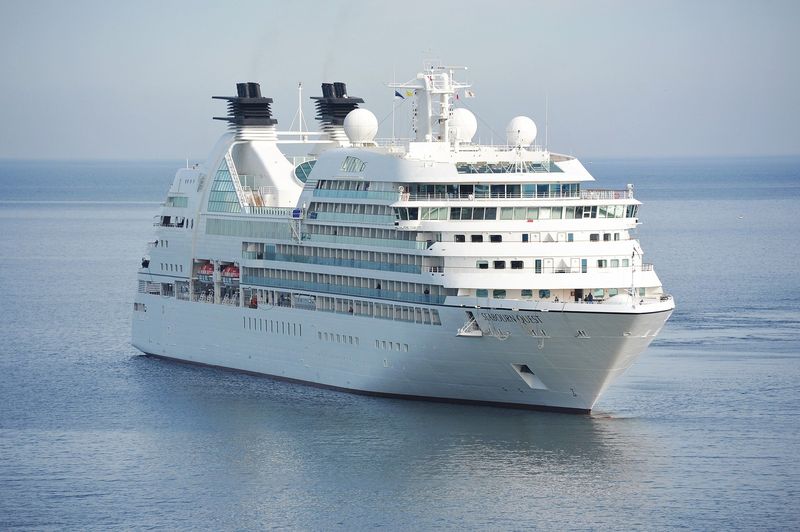
Cruise ships are equipped with multiple Diesel Generator sets to satisfy these power demands. These generator sets are larger and much more powerful than the DG sets found on a typical cargo vessel.
These are usually 5 or 6 in number and the power rating can be anywhere between 9-15 MW for each, which is approximately around 10 times the power rating of the DG’s on cargo ships.
Due to their large size, they command a separate compartment in the ship’s machinery space. This is called the DG room. Most modern passenger ships have two separate DG rooms, forward and aft, separated by a watertight bulkhead.
Each DG room has its independent air, fuel, lubrication and cooling water supply systems. This is for the purpose of safety and redundancy keeping in mind emergencies like fire and flooding.
The diesel engine prime-mover drives the alternator. The alternator supplied 3-phase power usually of either 6.6 kV or 11 kV to the main HV busbar from where it is either used directly or stepped-down to lower voltages.
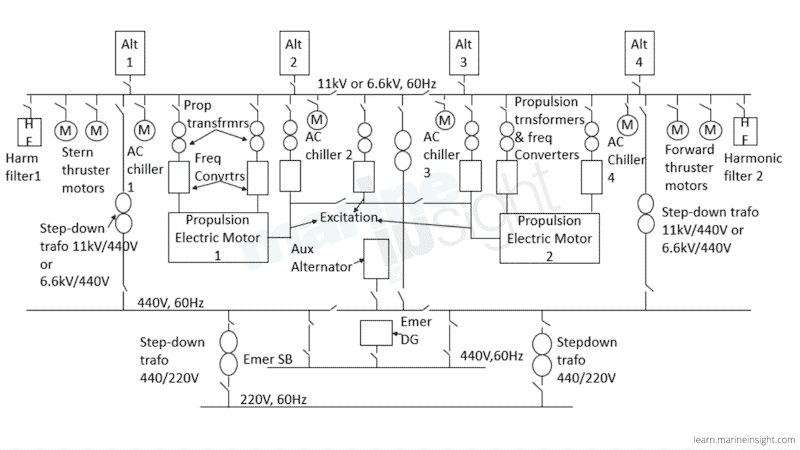
A typical passenger ship power distribution system is shown in the above illustration.
As we can see, the diesel generators (shown 4 in number) supply 3-phase high-voltage power to the HV busbar rated at either 6.6kV or 11kV.
There are different voltage demands on cruise ships according to the equipment. AC chillers, propulsion motors and tunnel thrusters typically have a high current demand. They get the supply from the HV busbar.
The Propulsion Electric Motors (PEMs) are a part of the diesel-electric propulsion powerplant. They require variable speed/torque in the case of fixed-pitch propellers. These are provided by thyristors or Silicon Controlled Rectifiers in the form of frequency convertors or cyclo-convertors.
Directional controls (ahead and astern movements) are obtained by changing the input phase sequence of the supply. This is by interchanging any two phases with the help of thyristors.
Each PEM has two separate stator windings known as half-drives. In case of failure of one half-drive, the other one operates the PEM, though at reduced power. Each half-drive has its own propulsion transformer and frequency converter.
Each PEM also has its separate excitation circuit. This is a direct current (DC) supply obtained from the main busbar after transformation and rectification. There are also two harmonic filters provided, at the port and starboard ends of the main HV busbar. These filter out unwanted harmonics generated by frequency converters and other HV components.
The 440V section takes care of most of the engine-room machinery loads such as pumps, compressors and fans. In addition, deck machinery and hotel loads are also supplied by it. The 440V busbar is fed from the HV busbar via step-down transformers.
In addition to this, there is also an additional auxiliary diesel generator for the restoration of power during blackout situations. This generator can be started to power the 440V busbar independent of the main supply, in order to prepare the plant for restart.
The auxiliary DG main breaker is automatically disconnected when the main DG starts and connects to the busbar.
An emergency generator is also available as per SOLAS , located above the uppermost continuous deck and away from the machinery spaces. This must start and come on load within 45 seconds of a power failure and supply power to the emergency switchboard. The switchboard provides power to selected critical equipment during blackout.
The emergency switchboard supplies power for the emergency lights, battery chargers, navigation and communication systems, a steering gear motor, sprinkler/hyper-mist pumps, a fire pump, a bilge/ballast pump, auxiliary DG pre-lube pumps, watertight doors , alarm and control systems and fire alarm system for a period of at least 36 hours on passenger vessels. On some vessels, power for one of the fuel oil supply pumps, booster pumps and starting air compressors are also supplied from the emergency SB.
In normal conditions, the emergency switchboard is supplied from the main bus bar. When there is a loss of main power, the supply breakers open and the emergency DG starts and takes over the supply to the ESB. On resumption of the main power, the EDG breaker is automatically disconnected. An interlock is available for this purpose.
The 220 V section takes care of the lighting loads and power outlets in accommodation and public areas. The 220V section is supplied from the 440V busbar by step-down transformers.
Diesel-Electric Propulsion
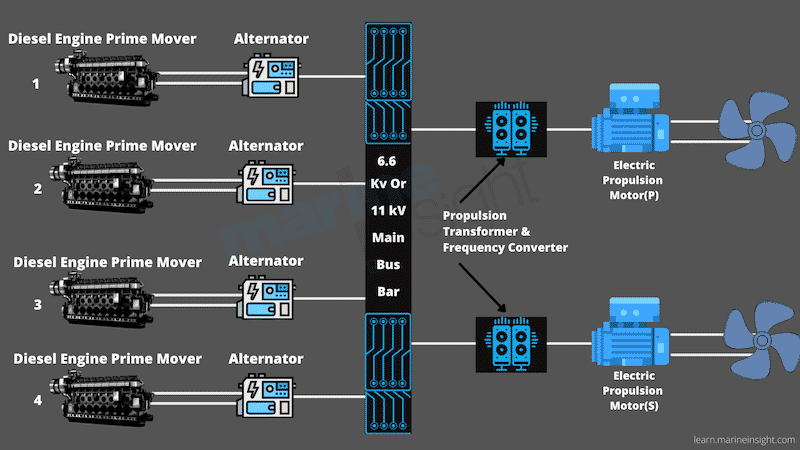
Most cruise ships are propelled by diesel-electric propulsion. The reason for this is that it has a lot of advantages over conventional propulsion system. These are: –
Flexibility of engine-room layout and huge space saving
DE propulsion does away with the need for the installation of a huge centralized 2-stroke main engine and auxiliary engines as on cargo ships.
Instead of this, the job of supplying electric power for the ship loads and for propelling the ship is carried out by the main generators. These generators allow for huge space saving and offers flexibility of location and arrangement.
The propulsion motors are themselves much more compact and lighter than conventional engines and being two in number. They allow for even distribution of weight athwartships.
This is even more amplification for DE propulsion fitted with azimuth podded propellers in which the need for shaft lines, stern tube, steering gear/rudder and stern thrusters is dispensed with.
Load diversity between ship service load and propulsion
The use of solid-state devices (diodes and thyristors) in the form of electronic converters for power circuits has enabled a single source of main electrical power (main DGs) to be used for all shipboard power requirements. This means doing away with the need for separate main and auxiliary generators.
The variable speed and torque requirements for the PEMs are handled by the convertors which convert fixed voltage and frequency to variable voltage and frequency for propulsion needs.
The other lower voltage ship loads are also supplied from the HV busbar through step-down transformers thus eliminating the need for additional gensets and reducing costs.
Higher propulsion redundancy
Two PEMs ensure redundancy as the failure of one does not render the ship to operate. Even each PEM has two separate drives or stator windings, known as half-drives which ensure redundancy. In case of failure of one of the windings, the other can be used to safely port the ship.
Economical part-load running
Slow-speed/part-load running does not affect the specific fuel oil consumption in DE drives in the same way as it affects conventional direct-drive engines. This is because the speed/torque is varied electrically by changing frequency and voltage.
The main DGs, irrespective of propulsion loads, always run at a constant speed and can be started or stopped as per load requirements. This ensures plant efficiency and results in considerable savings on fuel costs.
Ease of control
The electrical/electronic control of speed and direction (reversing), is quicker and smoother than conventional engines which largely rely on mechanical means for the same.
The lighter weight, even weight distribution and compactness of DE drives also contribute in the ease of control.
Low noise and vibration
On passenger ships, guest comfort is of utmost importance. A conventional direct-drive diesel engine comes with disadvantages of high noise and vibration, especially during starting, acceleration and deceleration.
This problem is done away with by employing diesel-electric propulsion. Starting, acceleration and deceleration is much quieter and smoother due to electrical control.
Emission Control
As a consequence of ergonomic design, lesser weight, efficient and optimized operation of the generators and reduced SFOC, emissions are also much less in a DE propelled vessel as compared to a conventional one.
Higher efficiency
The use of high voltage for DE propulsion is with the view of reducing current and conductor size. This also has the effect of considerably reducing copper, eddy and hysteresis losses.
The DE propeller efficiency is in the region of 87-90%.
Propulsion Electric Motor
An AC synchronous motor is usually employed as a propulsion motor on passenger ships. It is not self-starting unlike an induction motor.
This is because when the rotor is excited with DC current, the magnetic flux produced interacts with the rotating magnetic field of the stator.
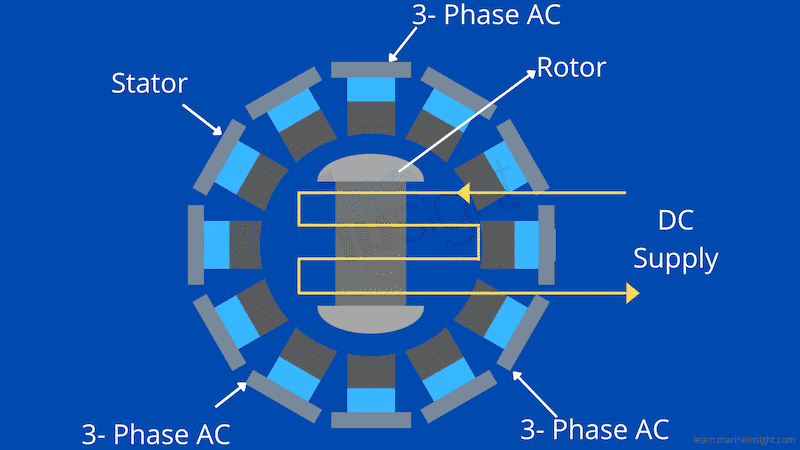
This interaction causes alternate attraction and repulsion due to a change of polarity every instant. Thus, it is unable to rotate because of its own inertia and requires additional help.
It is solvable by the use of either an external prime mover or a damper winding. An external prime-mover rotates the rotor to a speed close to synchronous speed after which DC is available for magnetic locking.
®A damper winding is an extra winding in the rotor provided in order for it to start as an induction motor. Once it starts and the speed nears synchronous speed, DC excitation is supplied and magnetic locking takes place.
Azimuth Podded propellers (Azipods)
This type of propulsion was pioneered by ABB in the late 1980s and has gone on to become a popular choice amongst passenger ship owners. It has become popular as AZIPOD, a name which has become synonymous with this type of propulsion, somewhat like XEROX for photocopiers.
Since then, apart from ABB, companies like Rolls-Royce and Schottel have also come up with their versions of the same.
AZIPODS replace PEMs, thrust blocks, shaft lines & bearings, stern tube, steering gear & rudder, stern thrusters and stern bossing, hence simplifying casing, making engine-room smaller. It also creates more room for commercial space on cruise ships, thus enhancing earning capacity.
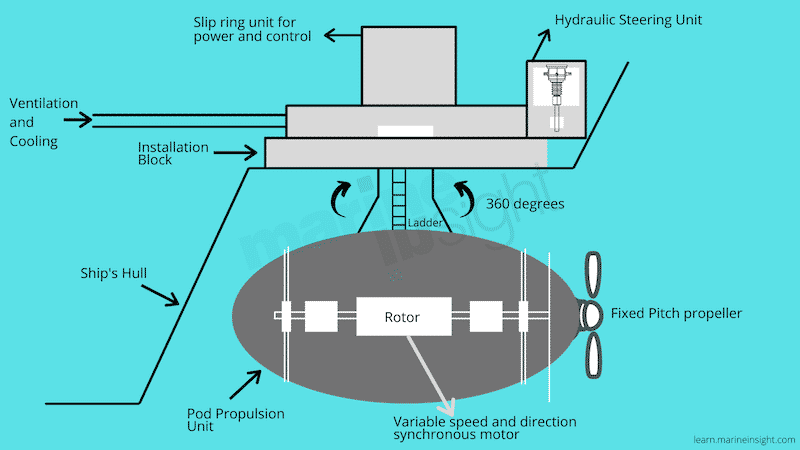
The AZIPOD is the first diesel-electric podded propulsion that is capable of azimuthing through 360 degrees. Their use has done away with rudders and stern thrusters.
There are around 100 cruise ships that have embraced this technology. These include Royal Caribbean International’s Oasis-class ships Oasis of the Seas, Symphony of the Seas, Harmony of the Seas and Allure of the Seas, to name a few.
Power cables from the HV switchboard connect to the PEM in a conventional DE propulsion system, which converts the electrical power to mechanical power. It then gets transmitted to the propellers with the help of lengthy shaft lines, bearings and thrust blocks.
These power cables instead go to a pod room at the stern where after getting converted to variable voltage and frequency by transformers and converters, they are fed to a slip-ring unit, rendering shaft lines and related equipment needless.
This slip-ring unit transmits this voltage and frequency-controlled power to the synchronous motor placed inside the pod.
A hydraulic steering unit aids in the 360 degrees turning capability which is useful during maneuvering. It is especially applied in many cruise destinations having smaller ports and limited tug assistance.
Reversing can be achieved either by reversing the propeller rotation or by rotating the pods 180 degrees. The latter helps to reverse the vessels without the need to reverse the prime-mover.
Advantages of podded propulsion:
- Increased energy efficiency (18-20%) with reduced fuel consumption.
- Improved crash-stop response.
- Reduced maintenance as it eliminates lengthy shaft lines and related equipment, steering gear/rudder, and stern thrusters.
- Reduced ship building time and expenditure as shaft installation and alignment works, bossing, stern thruster tunnels and installation works are not required.
- Excellent manoeuvrability even for large vessels.
- Efficient ice navigation.
- Enhanced space efficiency i.e., more flexibility of engine-room layout, smaller engine-rooms, more commercial and passenger space. This means more earnings.
- Increased redundancy because of the presence of multiple units (2 or even 3).
- Reduced emissions and enhanced energy efficiency due to lesser weight.
- Reduced noise and vibration and hence, enhanced passenger comfort.
- Reduced propeller size. This means cost saving, reduced maintenance and reduced chances of cavitation damage.
We saw how electric power is produced and distributed on cruise ships, how diesel-electric propulsion works, its advantages over convention 2-stroke engine driven centralized propulsion system and the latest avatar of DE propulsion (the podded propulsion system with its numerous advantages over both centralized propulsion system as well as traditional DE propulsion system).
Technological advancement in the design of ships is making rapid advancements and cruise ships are no exception to this. Each passing year, new technologies are being conceptualized, designed, experimented and fitted on new ships.
This makes the chips more efficient, powerful and environment-friendly than their predecessors. It also significantly reduces maintenance, man hours, costs and enhances the quality of life on board for guests and crew alike.
You might also like to read:
- How Do Cruise Ships Get Fresh Water?
- Top 10 Largest Cruise Ships in 2021
- Engineering Department Onboard Cruise Ships – A Detailed Guide
- How Much Fuel Does a Cruise Ship Use?
Do you have info to share with us ? Suggest a correction
Latest Marine Technology Articles You Would Like :

What is Eductor On a Ship?

What is an EchoSounder?

Practical Sample Kits by Normec MTS Allow the Crew to Take Water Samples Themselves

The Essential Guide to Bow Thruster Construction and Functionality

8 Biggest Ship Propellers in the World

Ballast Water Treatment System – A Boon For Many, A Menace For Some

Subscribe To Our Newsletters
By subscribing, you agree to our Privacy Policy and may receive occasional deal communications; you can unsubscribe anytime.
One Comment
this is a really good article to read
Leave a Reply
Your email address will not be published. Required fields are marked *
Subscribe to Marine Insight Daily Newsletter
" * " indicates required fields
Marine Engineering
Marine Engine Air Compressor Marine Boiler Oily Water Separator Marine Electrical Ship Generator Ship Stabilizer
Nautical Science
Mooring Bridge Watchkeeping Ship Manoeuvring Nautical Charts Anchoring Nautical Equipment Shipboard Guidelines
Explore
Free Maritime eBooks Premium Maritime eBooks Marine Safety Financial Planning Marine Careers Maritime Law Ship Dry Dock
Shipping News Maritime Reports Videos Maritime Piracy Offshore Safety Of Life At Sea (SOLAS) MARPOL

The Shipyard
For Those Who Love Ships
- Cruise Ships
How Cruise Ships Work (Part 3): The Bridge and the Engine Room
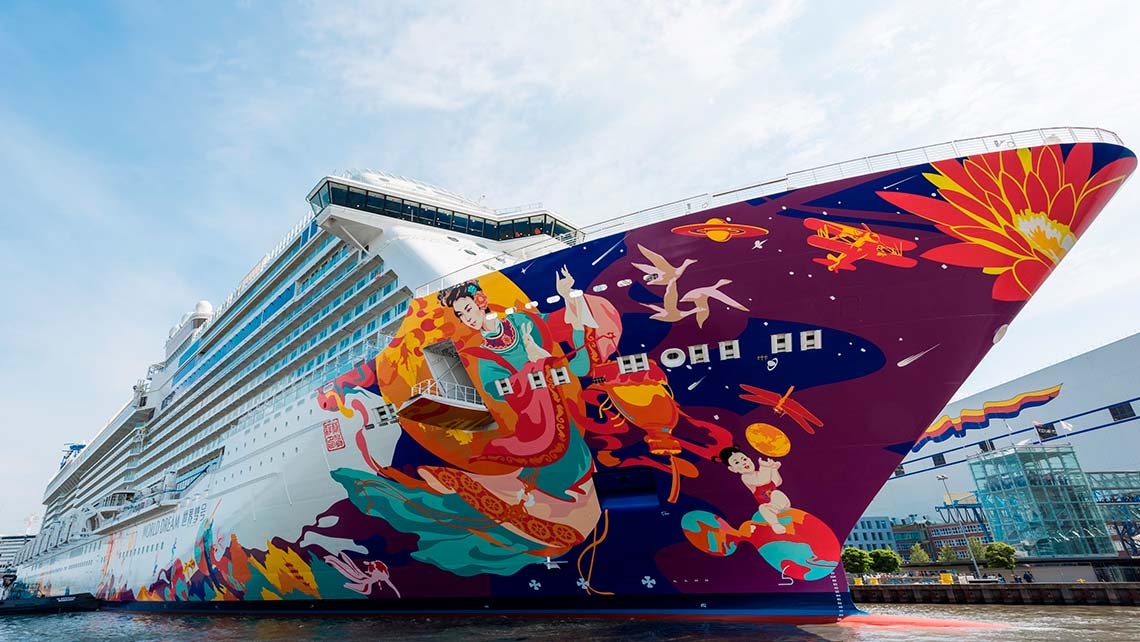
It’s like back in the days when we were little children. Grandpaw’s almost mystical tool shed was strictly off limits, but we were just dying to have a peek, weren’t we? Now that we are all grown up, Grandpaw’s gadgets are old news, but there is still a place or two on a cruise ship that remains like a pie in the sky for all of us obsessed by ships.
It’s the heart of the matter, it’s where it all happens, it’s the real deal. And if you are anything like me, you would gladly give away a day at the spa, a dessert buffet and even two, or the latest Marvel flick in the movie theater, just to spend a precious hour down in the noisy engine room of your favorite cruise ship. But life being proverbially unfair, modern cruise lines rarely allow their passengers to enter the bridge or the engine rooms of their ships, unless the visit is part of a specially organized guided tour. Some cruise ships have a window from which passengers can observe what’s going on in the bridge, but only if they promise not to disturb the officers. Which is really hard, when you badly want to touch everything…
So until the next time someone lets me out of sight and I make my umptieth attempt at trespassing to the engine room, let’s have a quick virtual tour of a cruise ship’s most forbidden and exciting parts.
The bridge is the brain of the ship. It is from there that the captain and his officers command and maneuver the ship, keep watch for other vessels or potential hazards, and navigate through the oceans.

For twenty-four hours each day, the bridge is occupied by two Deck Officers and two Able Seamen, traditionally in four-hour shifts. The main job of the Officer of the Watch is to monitor the ship’s systems and surroundings, and to ensure that everything is running safely and smoothly. During extreme weather, docking, or other special cases, the Captain of the ship is also present on the bridge to guide the deck officers.
The term “bridge” comes from the time of the paddle steamers, where a bridge was built above the two paddle houses that used to hold the paddle wheels. This way the skipper could observe both wheels, while moving freely between the two and giving out commands. On today’s cruise ships, the bridge is usually on the upper deck in the forward part of the ship and extends over the sides of the superstructure, allowing deck officers a view to the sides of the ship as well as down to the waterline. The side extensions are called bridge wings and often have a glass flooring for better visibility.

The bridge houses a number of important nautical devices and information systems for command and navigation of the ship.
Satellite Navigation
The signals emitted by special navigation satellites are picked up by the cruise ship through a special antenna. On board, a computer converts these signals into the exact position of the ship at a given time. On large ships, the position indicator is constantly recorded in a so-called electronic nautical chart.
Satellites also enable automatic positioning systems on modern cruise ships. The positioning system is controlled from the bridge and it uses GPS to ensure that the ship stays at a defined location. When the captain defines a position where the ship needs to remain for a while without anchoring, the system automatically maintains the ship in position by using the bow and stern thrusters.
Modern cruise ships carry a gyro compass and a magnetic compass. The gyro compass consists of a fast-rotating disk, usually positioned in a gimbal. It is a non-magnetic compass oriented parallel to the axis of rotation of the earth and thus indicates the north-south direction.

The gyro compass is more accurate and reliable than the magnetic compass and is therefore the primary reference point for steering the ship. The magnetic compass on board is more prone to inaccuracies and it serves only as back-up.
The word radar stands for Radio Detection And Ranging. Radars are devices that allow us to locate distant objects from a given location, regardless of visibility and weather conditions. The radar emits electromagnetic waves to an object, then receives back the reflected echoes from that object, and interprets them based on distances and angles. These interpretations enable us to determine where an object lies, and in some cases even what its contours look like. In the shipping industry, radars are used for monitoring traffic in ports and coastal regions, for collision protection, for collecting weather data, and for navigation.
Speed logs are devices that measure the speed of the ship. There are two main types of speed logs: Doppler logs and electromagnetic logs.
The Doppler logs send out underwater sound signals. When the sound wave reaches the sea floor, it gets reflected and then returns to the receiver of the log. Due to the movement of the ship relative to the seabed, a Doppler effect occurs and is evaluated by the device. As long as the sound waves can reach the bottom of the sea and return to the receiver, the Doppler log measures the distance travelled over ground. However, if it is no longer possible to use the seabed as a reference, the device uses particles suspended in the water, such as plankton and minerals, to measure travel through the water.

The electromagnetic logs create an electromagnetic field in the water around the ship, with the aid of a small alternating current and a transducer. A voltage proportional to the speed of the ship is generated in the water and is picked up by special sensors, which then transfer the information to an electronic device for interpretation. From the electronic device, the speed is then transmitted onto the displays in the bridge.
Echo Sounder
Cruise ships also have an echo sounder, a device used for the electro-acoustic measurement of water depths (sounding). The depth is determined by measuring the time between the emission of a sound impulse (water sound) and the arrival of the sound waves reflected from the bottom of the sea. The main purpose of echo sounders in cruise ships is safe navigation through waters.
Electronic Chart Display and Information System
The Electronic Chart Display and Information System (ECDIS) is a console, built into the bridge of modern cruise ships, which incorporates the main engine safety system, fire control system, monitoring and control system, power management system, propulsion control system and navigation and maneuvering system. The ECDIS allows for navigation of the ship without the need of traditional paper charts. Navigation can be done manually, automatically, or through the Navigation and Command System (NACOS).

The NACOS is the main software used to coordinate all factors that need to be taken into consideration, in order to navigate and maneuver the ship safely. The console is composed of a number of displays showing information from the radars and compasses, data about the course of the ship and planned maneuvers, the current status of the pitch of the thrusters, the speed of the ship, and anything else concerning the steering of the ship. An intelligent autopilot tracks changes in the behavior of the ship through navigational sensors. If the ship drifts off its course due to strong winds, for example, the system automatically responds to correct the change by sending signals straight to the engine room. Once the signal is received by the engines, the rudder or thrusters of the ship are activated and move to the position given by the system. The displays on the bridge show both the angle of the rudder or thrusters, as well as the rate and the radius of the maneuver in progress.
The Engine Room
The engine room is the heart of a cruise ship. It is here that pistons hammer and crankshafts turn to propel the ship forward. It is the loud and oily place where the Chief Engineer and his team work around the clock to ensure that everything is running smoothly. It is the engine room of the ship that allows for the luxuries of air-conditioning, electricity, and plumbing on board cruise ships.

In future articles we will have the chance to explore the contents of the engine room in all the excruciating detail that they deserve, so to all the techies out there – I’ve got you covered. Just stay tuned.
Most larger ships have more than one engine room to house their machinery. The arrangement of the engine room can vary depending on the type, design, and size of the ship. For stability reasons, the engine machinery is typically placed as low as possible in the ship’s bowels and often takes up several decks in height. The machine rooms are split into watertight compartments, each housing different machinery.
Today’s cruise ships operate on diesel or diesel-electric engines. Their operating principle does not differ much from the old days of coal steamers, except for the medium used to generate power. While back in the day ocean liners used steam to move the engine’s pistons, modern cruise ships use diesel fuel. Today’s diesel engines are composed of the engine unit itself, gearboxes, shafts and generators. Some ships also have shaft generators which create electricity from the turning movement of the propeller shaft. The electricity is then used in the cabins, on deck and in the kitchens.

The latest generation of cruise ships are equipped with diesel electric engines. Instead of the more traditional engine-shaft-propeller arrangement, in this case the engines are connected to generators to create electricity. The generators power electric motors, and the electric motors move the propellers.
Aside from the engines and generators, the machinery that occupies the engine rooms includes pumps and heat exchangers for engine cooling, stabilizer fins and their motors, as well as the ship’s bow thruster system.
Since all of the equipment in the engine room is highly dependent on electricity, modern cruise ships also have back-up generators, usually located outside the main engine room, to protect them in case of fire. While these generators cannot produce enough power to keep the ship moving, they produce enough to keep some of the vital functions of the ship running, such as powering the emergency lights and the communication and navigation systems. In case the back-up generators fail, cruise ships are also equipped with a back-up battery that allows some of these functions to continue running for short periods of time.
All the machinery in the engine rooms is monitored in the Engine Control Room (ECR). The ECR is a room full of screens, lights, alarms, and switches from where the current operational status of every piece of equipment can be checked.

The main switchboard of the ECR is used to distribute the generated electricity to where it is needed on board. The ERC is also where the engineering team comes together to discuss and plan the safe running of the engine rooms, to take decisions in emergency situations, to consult the technical manuals and drawings of the ship, to restart certain pieces of machinery if necessary, and to maintain communication with the bridge. Communication between the ECR and the bridge is crucial for the safe operation of the ship, especially during docking, moving through shallow waters, maneuvering, and changes in the course or speed of the ship.
This concludes our three-part overview of how a cruise ship functions. Now that we have covered the basics, in future articles we can explore all the specifics to our hearts’ content. As always, don’t hesitate to leave your constructive comments below and feel free to suggest topics you want to know more about – chances are I want to know more about them too!
Stay in touch and I’ll see you next time!
Share this:
Leave a reply cancel reply.
Your email address will not be published. Required fields are marked *
Privacy Overview
Cruise Ship Engine Room (Everything You Want to Know)
Disclosure: This post may contain affiliate links. We may receive compensation when you purchase via my links at no cost to you. See my disclosure for more information.
Cruise ships require a lot of power to sail and operate. The cruise ship engine room is both mysterious and fascinating because it’s hidden from passengers.
Passenger ships have come a long way from sails and steam engines. Modern cruise ships use diesel-electric engines, while newer cruise ships are moving towards more environmentally friendly solutions like liquified natural gas.
Here’s everything you need to know about a cruise ship’s engine room.
Table of Contents
Where is the Cruise Ship Engine Room?
The engine rooms on cruise ships are located on the lower decks, between the midship and the aft. The engines aren’t quite at the back of the vessel but closer to midship.
There are several reasons for keeping the cruise ship engine room away from passenger areas.
- Stability : Placing the engines and heavy equipment below sea level helps keep the ship stable and prevents cruise ships from tipping over .
- Noise : Engine rooms are extremely noisy. Naval engineers compensate by incorporating sound reduction features and noise dampeners. However, the sound and vibration wouldn’t be pleasant for cruise ship passengers.
- Security : The engine room spaces are in crew-only areas for safety and security purposes.
Most of the heavy machinery on a cruise ship is located on the lower decks, just above the keel. The positioning of the engine room, other machines, and technical equipment give the massive vessels a lower center of gravity.

Although you might envision the engine room as a massive open room running the ship’s length, the lower decks are divided into several water-tight compartments. One compartment may house the cruise ship water fresh water systems , another for the main engines, and another for the air conditioning.
The division of the engine room into separate compartments is for safety. Dividing the engine room into different containers makes it easier for the ship to contain the damage if there’s a fire or leak in the hull.
Cruise ship fuel tanks are also on the lower decks, but they are kept separate from the main engines.

Crew members can monitor the ship’s systems from the engine control room. From the operation control center, crew members monitor the ship’s systems and act as a central area for maintaining the technical equipment on the cruise ship.
Every piece of equipment can be monitored from the engine control room to ensure the cruise ship runs smoothly.
The room is monitored 24/7 by watchkeeping teams. Each crew member is assigned specific machinery. For example, one person may be responsible for the freshwater generators and water pumps and another for the fuel oil systems.
How Big is a Cruise Ship Engine?

A cruise ship engine room spans several decks and holds the ship’s engines, fuel tanks, water systems, generators, control room, engine workshop, air conditioning, and other essential navigation systems.
Modern diesel-powered cruise ships have between four to six medium-speed (500 revolutions per minute) engines . Each engine can generate upwards of 25,000 horsepower or nearly 18.5 megawatts.
The engines on a cruise ship can be up to 45 feet long, 27 feet high, and weigh up to 275 tons .
These massive engines can propel cruise ships at an average speed of 18-22 knots .
Cruise Ship Engine Technology
Cruise ship engine technology has evolved from wind and sails to newer liquified natural gas technology.
We’ll cover some of the most popular technologies used by cruise ships.
Steam Engines

When the cruise industry began in the mid-1800s, vessels were propelled by steam engines.
Steam engines had boilers that used wood for fuel. Later steam engines used coal.
The boiler produced steam which created pressure in a pressurized system. The pressure moved pistons which drove the propeller shaft.
The Titanic was powered by two huge triple-expansion steam engines and a small propeller. ( Source )
Diesel Engine s

Diesel engines propel most modern ships. Cruise ships may have four to six medium-speed (500 rpm) engines producing 8-10MW each .
Diesel engines work on the same concept as steam engines. Rather than steam, the ignition of diesel fuel pushes the pistons up and down, turning the crankshaft attached to the propeller shaft.
Many of today’s diesel-engine cruise ships also employ a shaft generator to generate electricity for shipboard services, like lighting.
A shaft generator converts the circular motion of the propeller shaft into electricity. However, shaft generators only operate when the ship is moving. And can’t generate electricity while docked in port.
Diesel-Electric Cruise Ship Engines

Almost all new diesel-powered cruise ships use diesel-electric engines.
The engines work the same as a traditional diesel engine, but rather than connecting to the propeller shaft – diesel-electric engines connect directly to large generators .
A diesel-electric engine has one job, generating electricity.
The electricity produced by the engine is used to power the ship’s propellers.
These engines provide greater efficiency than traditional diesel engines.
While connected to a generator, the engines can run at their most efficient settings regardless of the travel speed . Whether the ship is sailing at 10 or 20 knots, the engines can operate a peak efficiency.
Diesel-electric engines are popular because of their ease of control, low noise, minimal vibration, and relatively compact size compared to other forms of propulsion.
Marine vessels that run on diesel power must carry exhaust-treatment systems and catalytic-reduction equipment to reduce the environmental impact of the ship.
Gas-Turbine Power System

Royal Caribbean Group was the first company to experiment with gas-turbine systems.
Compared to diesel engines, gas turbines offer several advantages, including:
- Lower environmental impact.
- More reliable.
- Take up less space.
- Gas engines require a smaller maintenance crew and less inventory.
The heat generated from the engine is recovered and used to produce electricity for other onboard systems, such as air conditioning and water heating.
Despite their advantages, gas propulsion is not widely used in the cruise industry. Gas-powered ships are faster, but most cruise ships don’t travel faster than 22-25 knots .
Diesel engines have greater fuel efficiency at slower speeds , and the high gas price compared to diesel makes them more costly to operate.
LNG Powered Ships

Many new cruise ships are propelled by liquified natural gas (LNG).
LNG is the cleanest fossil fuel currently produced. According to Cruise Critic , LNG-powered cruise ships can “reportedly reduce sulfur emissions by as much as 99 percent and nitrogen oxide emissions by up to 85 percent.” LNG can reduce carbon emissions by up to 20 percent .
The special engines of LNG-powered cruise ships use natural gas cooled to approximately -260°F. Once cooled, the liquid form of natural gas is about 600 times denser than natural gas , making it easier to transport.
Carnival Cruise Line announced the first LNG-powered vessels in 2015, using a “dual fuel” design. The ships can burn both liquified natural gas and marine fuel, reducing the required fuel storage space.
AIDAprima became the world’s first LNG-powered cruise ship on her debut in 2016.
Natural gas is purer, cleaner, more efficient, and cheaper than other fossil fuels . But it’s a relatively new technology, and not all ports have the facilities for refueling LNG-powered ships.
Because natural gas burns cleaner than other fossil fuels, the engines require less maintenance. But LNG has a lower fuel density than diesel, so LNG vessels need fuel tanks that are twice the size.
Emergency Generators
Every cruise ship has an emergency generator to maintain vital electrical power in case of engine failure.
The emergency generators are located away from the main engine room, usually on a higher deck. Their location isolates them from catastrophic damage in the engine room (for example, a fire).
The generators can operate critical navigation systems, emergency lights, and other vital equipment. But emergency generators can’t power the ship .
Larger ships may have multiple emergency generators. But due to the size constraints, they can’t produce the same power as the main engines and cannot propel the ship.
What happens if the generator fails?
Cruise ships have several redundant systems to ensure the safety and security of passengers. If the generators fail to work during an emergency, cruise ships have an emergency battery backup to power the most critical systems for up to 24 hours .
Shore-to-Ship Power Supply
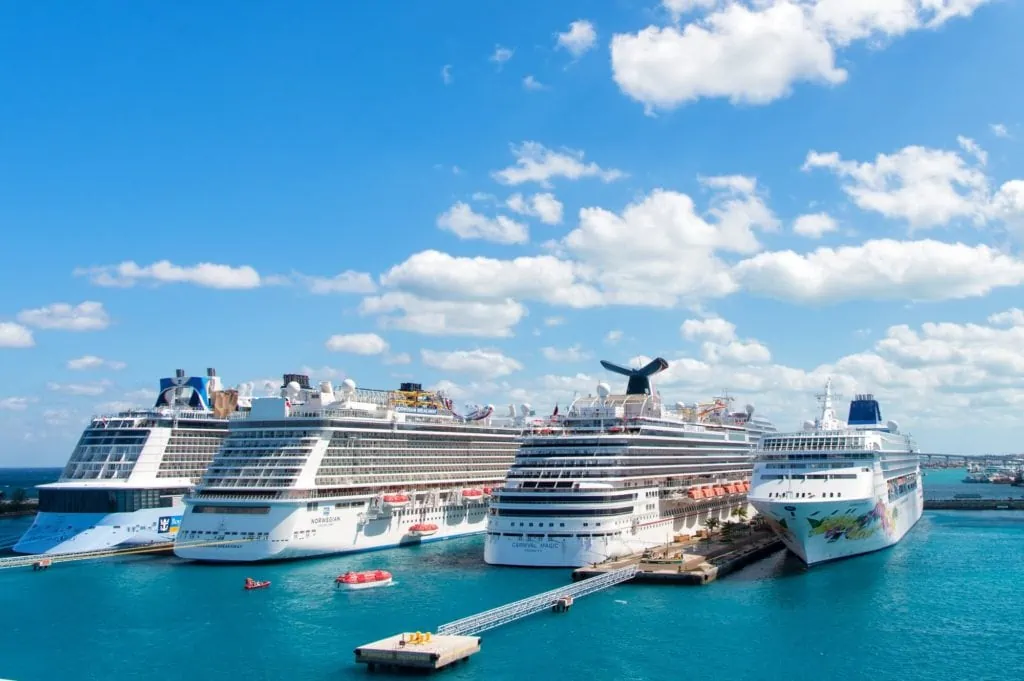
Despite innovations in engine technology, cruise ships produce a lot of pollution.
To further reduce ships’ environmental impact, many cruise ships can connect to the cruise port’s power grid , known as “shore-to-ship power” or “cold ironing.”
In the past, cruise ships kept their engines running while docked to generate electricity for shipwide services.
But most of the energy produced by the ship’s engines goes towards powering the propellers, and running the engines while docked created massive energy waste.
Some cruise ships used smaller generators to power the hotel and amusement functions. The smaller generators allow cruise ships to shut off the main engines in port, reducing pollution.
Modern cruise ships are equipped with systems to “plug in” to the local power grid. Even some older cruise ships are being retrofitted to allow for shore-to-ship power.
Not all cruise ports have facilities to enable shore-to-ship energy. But many larger cruise ports have dockside electrical hookups that allow cruise ships to shut off their engines and run on the city’s electrical grid. The technology reduces harmful emissions by up to 95% while ships are docked .
Considering how much time cruise ships spend docked at port, it significantly reduces sulfur and carbon emissions.
How Loud is the Engine Room of a Cruise Ship?

A cruise ship engine room is incredibly noisy, exceeding 173 decibels . At this noise level, the noise in an engine room can cause immediate damage to your hearing without proper ear protection.
For reference, a gunshot is 130 decibels.
Engine rooms have insulation and sound-reducing technology, so it’s not as noisy. To prevent hearing damage, crew members must wear hearing protection when entering the multi-story engine room.
But guests don’t have to be concerned about the noise.
Thanks to the insulation and sound dampening, you’ll only hear a slight “purr” if you’re near the engine room.
You may feel the engine’s vibration if your cabin is on the lower decks, near the aft . On most ships, the noise isn’t enough to cause any annoyance or trouble sleeping.
But if you’re a light sleeper, accommodations near the engine room are among the worst cabins on a cruise ship .
Where are the Fuel Tanks?
The fuel tanks are located below the passenger decks , near the engine room. The fuel is stored in double bottom tanks.
How Much Fuel Can a Cruise Ship Hold?
A large cruise ship of 1,100 feet in length can hold between 1 to 2 million gallons of fuel .
It’s enough to power the cruise ship for up to two weeks of sailing without refueling.
Are There Cabins Near the Engine Room?
Newer cruise ships have a large gap between the cruise ship engine room and passenger cabins to minimize noise and vibrations.
However, you may still find cabins reasonably close to the engine room.
If you book a cabin near the engine room, you can expect to hear some noise and feel the vibrations caused by the engines . However, cruise ships use sound-dampening technology and insulation to minimize noise pollution.
The engines are typically cheaper because most passengers avoid booking cabins next to the engine room.
Cabins near the cruise ship engine room aren’t noisy enough to cause annoyance or sleeping issues.
If anything, the vibrations caused by the engines are more likely to cause annoyance over the sound of the engine .
How Much Fuel Do Cruise Ships Use?
It takes a lot of fuel to power a cruise ship.
The average cruise ship uses around 18.3 gallons of fuel per minute or 1100 gallons per hour . ( Source )
Marcello De Lio
Leave a Reply Cancel Reply
Your email address will not be published. Required fields are marked *
Name *
Email *
Add Comment *
Save my name, email, and website in this browser for the next time I comment.
Post Comment
This site uses Akismet to reduce spam. Learn how your comment data is processed .
Trending now


This is How Cruise Ships Work
by Contractor | Nov 24, 2020 | resources , Travel Tips | 0 comments
Are you wondering how cruise ships work? Whether you’re planning a trip or just curious about a cruise ship’s technicality or even the logistics, it’s always intriguing to find out how massive ships like work. How does a cruise ship work?
First and foremost, a cruise ship’s heart is in the engine of the vessel. The engine’s design, paired with proper fueling, provides the power for the ship’s mobility and all the entertainment aboard. The ship’s engineering and the logistics of running a cruise company play a role in shaping how a cruise ship works overall
If you are an engineer curious about a ship’s mechanics, this is an article for you. Fortunately, if you’re just a curious traveler wondering how a cruise vessel will shape your next trip, this is also for you, so read on. There is so much to a cruise ship other than the cocktails and fun parks on top. This will be an eye-opening article for all audiences.
How Do Cruise Ships Work

To the ultimate question, “how a cruise ship works,” let’s dive into how it works mechanically. What are the technical and mechanical aspects of a cruise ship? What does an engine do? How does a massive ship provide light, food, entertainment in the middle of an ocean? Is the water safe to drink?
Then, after reviewing how the cruise ship’s mechanics work, the answer to how a cruise ship works logistically can be answered. How do companies make a profit from these vast ships? How do the ships prepare for new passengers?
Technical Aspects of Cruise Ships
The technical aspects are a vital part of a cruise ship, so it will be first visited. Not to state the obvious, but the ship’s heart is shaped by the crew and the engineers that have put many hours and dedication into making a cruise ship work.
This is article will reveal the true hidden layers of what makes it all work starting from ground zero, the heart.
Technical Aspects
If you want one thing in a cruise ship aside from the cocktails and a nice tan, it’s the vessel’s stability and durability. Whether you are traveling through an unexpected storm or cruising on a gentle wave, your cruise ship should be the most stable in all situations.
How are cruise ships stabilized? The general idea for balancing and maintaining buoyancy is distributing the weight throughout the ship correctly, and of course, displacing the right about of water as it moves. So, let’s first talk about one of the most massive machinery onboard, the engine. Where does it sit and how does it run the cruise ship?
Engine Rooms
Where are the engines located? You guessed it, most heavyweights, such as engines, are found as low as possible in the lower decks, ground zero. For most cruise ships, the engines are close to the keel. The structural keel is the most closes to the bottom of the vessel and the ship’s wide hull. It runs the length of the vessel down its centerline and in most ships, you won’t have to go far to find the engine rooms.
Just because it’s placed low in the ship doesn’t mean it doesn’t take a lot of space. For all the ship’s power, the engine rooms can take up several decks high and are generally divided into several compartments. It may not feel like an open massive space, but it is truly the heart of the ship and the design of the rooms and placement are critical.
Usually, the primary concern for most ships is have engines and machinery compartmentalized for safety and avoiding fire hazards. Compartmentalized and labeled rooms make maintenance simpler and enhances safety for unprecedented accidents.
New legislations also support the requirement for compartmentalization. Ships are required to have at least a duplicate of equipment and at least two separate spaces for engines. So, what about these engines? Why are they so important and why do ships need so many of them?
Power and Engines
Just to answer those questions, we’ll have to visit more fundamental questions such as: How do the engines power a giant cruise ship? How does it help the ship propel forward? Are there specific engines that power different parts of the cruise? Out of many questions regarding the engines, the answer starts with the main engines.
The main engines are the engines that produce the majority of the power for the cruise ship to move. Depending on the type of vessel, the main engine connects to different parts of the propelling power. From traditional steamboats, to diesel electric, the engine is the fundamental powerhouse for the entire ship on the sea.
The following table is a general overview of how engines on different types of vessels are connected to the ship’s requirements.
So How Do These Engines Make the Ship Move?

As shown in the table, depending on the vessel type, the engine will provide power to different aspects of the ship. More or less, everything is distributed to operating proportions, but the key mechanics differ from one to another.
Diesel may be something more familiar to what we saw in old movies with steamboats. Even in modern days, we use similar mechanisms, if not labeled the same. The main difference is the source of pressure, which can be the traditional steam, or a fuel ignition.
Whether it is steam (traditional) or fuel ignition, the pressure generated from either push the pistons up and down in the vessel. These pistons connect to crankshafts through gears, which turns the pistons.
The crankshaft connects to the propeller through a long propeller shaft and gears, which further determines its speed in traditional diesel-powered vessels by steam pressure. Generally, the faster the pistons move up and down from the pressure, the quicker the propeller shifts would move.
With modern designs that control the propeller speed, engineers placed the gears in between the propeller and the engines which further enhances efficiency for both engines and propellers.
Again, although the majority of the engine provides electricity to the propeller shaft, electricity must be provided to the rest of the ship for entertainment. Often, options such as a shaft generator offer power to outlets such as lighting the dining and general appliances onboard while in motion.
Diesel-Electric
Diesel-electric is another form of vessels that are found commonly with conventional diesel vessels. Unlike the conventional diesel, diesel-electric engines are connected directly to the generators that provide the electricity for the propellers and main generators.
This electricity also provides direct power for the ship’s lights, appliances, and much more.
Environmentally Friendly Power

On a side note, if the thought of diesel in the ocean disturbs you, there is some good news! Thankfully, more and more environmentally friendly options are appearing for cruise ships. For example, liquified Natural Gas (LNG) is an alternative method for powering ships that burns natural gas for power.
Using natural gas could reduce nitrogen oxide and carbon dioxide emissions significantly! With green-oriented companies, more green cruises have been released in the past few years.
That being said, if you are looking to book a trip, be on the lookout for green cruising opportunities! Onboard, you can also find environmentally conscious crew members and less-waste policies.
Source: CruiseCritic , Windstar Cruises , Green Cruises
Fuel Consumption
So, how does fuel play a part in powering the engine and the cruise ship? Let’s go back and visit what an engine does. An engine generates electricity to the propellers by supplying power the propulsion motors. How do they get the electricity and what makes an engine work? Most likely fuel and ignition (besides the steamboat example from before).
How much Fuel?
In general, a large cruise ship can consume up to 250 tons of fuel a day, which is close to 80,000 gallons a day. For medium size cruise ships, consumption can still range up to 150 tons of fuel a day.
Onboard, a ship may carry up to 1 to 2 million gallons of fuel, depending on the vessel size. Most of the power, which can be close to 85%, goes to the propellers, while the rest goes to keeping the cruise lit and comfortable for the passengers and crew members.
While passengers dine and enjoy their cruise aboard, crew members are constantly maintaining the proper fuel levels and providing proper power for the ship. As for the captain of the ship, he also has several variables to keep in mind to control fuel consumption and safety.
Fuel consumption may vary for several reasons, just like when we are driving our cars (but with more variability). For example, depending on where the wind is hitting the ship, the fuel consumption can go 1 – 5% over the average consumption rate.
Here is a short list of variables that the captain is keeping track of:
- Speed of the cruise
- Sea conditions (vs. sailing direction)
- Weather (including the direction of the wind)
- Size of the ship
- Engine (Gas turbines, diesel-electric, diesel, or electric)
Source: Windstar Cruises , Cruise Mapper
Overall, the fuel, power, and engine, are all functions of making the magic happen. Starting from the design of the engine, to the crewmembers and captain maintaining the fuel and power consumption, a lot of action happens behind the scenes while passengers are onboard during vacation.
Floating and Buoyancy

Now that the ship is powered, how do we ensure that it floats? How do these massive machineries, ice-skating rinks, restaurants, and bars float on water while keeping thousands of passengers safely onboard?
While the cruise ship constantly pushes the water out of its way when moving forward, the water being pushed will try to come back to its place. This displaced water pushes back with a force on the vessel which lets the cruise ship stay afloat.
This is the general idea when engineers designed the hull of the ship. This ratio has to be calculated when designing a ship and has to be correct. If you get a chance to see the hull of most ships, they have a wide U-shape hull at the front to maintain the displacement.
In addition to basic buoyancy principles, an engineer must also consider the ship’s average density. This means that the ship’s general open spaces must be considered on top of the vessel’s average weight, so the vessel remains “less dense” than the ocean’s (usually salty) water. A great example is a rock sinking vs. a beach ball floating on water.
Source: Express
Water Onboard
So the power, fuel, engine, and buoyancy are the fundamentals of the ship. What about the details of the cruise ship such as the water in your shower? Is it salty? Is it fresh? Where and how does that come to your room without running out.
In general, most cruise ships have a steam-evaporation system. Water is pumped and desalinated before going to your room. During this process, your water is distilled and desalinated using a reverse-osmosis system and filtration system.
Distillation and desalination process uses a purification system to take all contents out of the water. This is generally not healthy to drink, so this water is mineralized and chlorinated for taste and safety.
Additionally, some ships have water brought onboard for laundry and other maintenance purposes. Generally speaking, the water onboard available for drinking are tested and checked for purification. If you are ever in doubt, check with a crew member to ensure the water is safe for consumption.
Is the Water Safe?
The answer to your ultimate question is, no, the water you are drinking is not toilet water. Regulated by the Maritime Organization laws, all “toilet water” must be treated and discharged into the ocean at a specific distance from the land. This water is never treated and recycled for passengers to use again.
On a side note, if you feel uncomfortable drinking this water, bottled water will most likely be available onboard for purchase. If you need special water for medical needs, you will most likely be able to bring a few bottles on board by notifying them ahead of time.
Now that we have reviewed how cruise ships work mechanically, let’s dive into the ship’s logistics. How do they work? Who’s working, how is it supplied, and how are they so cheap? Or perhaps, why are they so expensive? All of these questions come down to logistics.
General Logistics
Depending on your opinion and type of cruise you may have signed up for, you may think that your cruise is way under or over-budget. The cruise companies measure these decisions and prices to minimize cost and maximize returns (of course).
For example, cruise ships avoid fines by taking specific lines. They must often save fuel and hiring a knowledgeable captain who can make these decisions and keep passengers aboard safe is essential.
So, what are the different divisions of a cruise vacation? Are some better than others?

Mainstream, Premium, and Luxury

If we broke down cruises into 3 main categories, we could look at the mainstream, premium, and luxury lines of cruise types. You will often see categories within each of these types, but let’s break them down into the major categories for simplicity.
First, we will start with the mainstream cruise lines. These are cruises that are readily available, common, and well-known by the public with reasonable ticket costs.
Generally, these cruises’ primary business is through the onboard casinos, spas, shopping, and drinks. They suit the needs of most passengers. To make maximum profit, companies design these cruises by providing readily available entertainment on board. Most passengers are estimated to use 500$ onboard for their vacation experience.
Onboard, you will find general amenities, restaurants, bars, pubs, nightclubs, shopping, theaters, cinemas, swimming pools, gyms, karaokes, libraries, and even museums! These are great for big parties and are generally the biggest ships at sea.
Examples of Mainstream Cruise Lines that are known as “floating resorts”:
- Carnival Cruise Line
- Royal Caribbean International
- Norwegian Cruise line
- Lindblad Expeditions
- Amawaterways
Mainstream cruises are great for
- Group of friends
Source: NancyandShawnPower , Fodors , and Wind Rose Network
Premium lines are perfect for adults or those that are retiring. The brilliant catch is that many have policies of “no kids allowed,” making it an excellent selling point for adults who need some peace and quiet. These cruises make money upfront by offering more access to ports and offering the serene luxury.
Premium cruises generally have a refined style in comparison to mainstream cruise lines. Activities are more focused on lifestyles. For example, you may find computer classes or a language-learning class. Besides, these ships still offer resort-style pools, game nights, bingo, spas, gyms, and maybe even a jazz night.
The perks for a premium in comparison to the mainstream is the higher quality of cuisine. Usually offering specialty restaurants and quality chefs, the price may be higher, but the overall quality is higher. The rooms at premium cruise lines are also superior, often offering suites and rooms with balconies.
Examples of Premium Cruise Lines
- Princess Cruises
- Celebrity Cruises
- Holland America Line
The popular audience for Premium cruise lines:
- Older Adults
- Sometimes family-oriented
Source: Fodors
Luxury lines are pricier yet offer the best-selling point, fewer people onboard with a luxurious experience from beginning to end. The more expensive tickets provided to only a few hundred passengers make a profit for the company with the much higher ticket prices.
There are abundant space and a deluxe ship that will greet you as a valued guest from beginning to end for the high price. No doubt, one will fall for such an exquisite experience that starts from fine dining of caviar and foie gras to personal service available at one’s fingertips.
Course meals are offered from a full restaurant menu in your stateroom and served with limitless wine. Most interiors are luxurious and elegant, with rooms that are large and overlooking the sea.
Amenities range from gyms, spas, pools, and low-key entertainment. Generally targeting a niche group, most luxury cruise lines do not allow children.
Examples of luxury cruise lines:
- Windstar Cruises
- Paul Gauguin
- Silversea Cruises
- Crystal Cruises
- Oceania Cruises
Source: Cruise Critic
Many corporations own several of these different targets to make the most profit. Additionally, by corporations owning various cruise types, they can also hand down older ships throughout their other brands.
Logistics throughout the year

In addition to managing several types of cruises, there are numerous ways cruises have to operate to maintain their profits and not waste money through resting and selecting the wrong routes.
For example, cruise lines generally have high sales in November through April by Americans. The cold Americans usually take a warm vacation away from winter for a trip to the Caribbean.
What about other times of the year? Staying on seas without business is a considerable loss in revenue and usually unheard of. So, what do they do? They sell repositioning one-way tickets in April!
Generally, towards the end of April, you will start seeing two-week trips from the Caribbean to Europe. Typically, these trips can range from any state on the Eastern Coast of the United States to European countries.
Switching over/Cleaning
When there are one-way trips, there also needs to be exceptional coordination for a short turnaround between trips. When the cruise ships get to the destination, all hotels, theaters, dining, laundromat, and parks are cleaned and reset for the next people to come on board within half a day!
How do they do it?
During night-time, luggage and bags are ready ashore for passengers to check out. Meanwhile, all the trash is dumped, and the trash containments are cleaned, crew members switch, fuels are refilled, and food is refreshed with new inventory.
Remember the 1 to 2 million gallons of fuel to refill? This process, called bunkering, is a whole-team effort and is completed before the ship is ready to travel again.
A small boat, a “barge,” brings fuel to the 400 ports fueling for ships.
- Barge secures to the side of the cruise ship
- Connects a hose between the ship tanks
- Pumps fuel while watching guard
When passengers load off, then the cleaning crew comes to clean the rooms. While the ship is pampering, they complete paperwork from the first trip, fulfill any necessary maintenance, redecorate rooms, and start preparing and cooking food and lunch for the next set of passengers coming on board.
Soon, the ship is reloaded with happy passengers and starts to move again. They make their profits from when the Casinos start, and food is served.
Crew Members
This brings light to the less noticed crew members. The ones that make all the magic happen. Generally, a cruise will have 1 crew for 2 passengers. Most of the crew members are working very long hours for several months.
In general, these crew ships are in their rooms when not on duty and do not get in the passengers’ way. How do cruises afford these crew members and their extended hours of work? The trick is that cruises can register in any country to abide by their labor laws. This is how they keep costs low, but there is a catch to that.
Crews and Destination

So, there is a catch, but it impacts your travel too. Did you ever wonder why cruises took less than expected stops? Not necessarily detours or emergency stops, but maybe a cruise led you to Ensenada or the Tabuaeran. This is due to the Passenger Vessel Services Act of 1886.
Why do cruises take weird detours?
Generally, a cruise ship can register any Labor law, as stated above. This makes it easy for cruise ships to pick a non-American country since it is cheaper and easier to fulfill (for business purposes). Unfortunately, if they choose this option, they must also abide by the Passenger Vessel Services Act of 1886. This act states that “No foreign vessel shall transport passengers between the United States.”
This means that if the cruise ship is registered under another country, they can never directly stop at an American stop if their initial take-off was in the United States. This is why you see stopes in Ensenada, for example.
For example, before Norwegian registered as American, if their cruise trip was to Hawaii from the motherland, they had to stop at Tabuaeran, a small island nearby.
When Norwegian registered as American, this let them bypass the Passenger Vessel Services Act. Unfortunately, this led the crew members’ service fees to rise, which led to higher ticket prices. If you want to watch how the above logistics work, check out this video !
A Cruise Ship Overview
Starting from the engine, fuel, and engineering to the logistics of companies, crewmembers, and governing policies, a cruise ship works in a marvelous way to shape every passengers’ experience abroad.
Thousands of crewmembers across various cruise ships, engineers of several centuries, and many hours of dedicated personnel make a cruise vacation work. Next time you are enjoying a cocktail on deck, remember that there is so much more behind the meaning of your cruise. There are so many parts that worked to make it happen! Enjoy and bon voyage!
Related Posts:

Submit a Comment Cancel reply
Your email address will not be published. Required fields are marked *
Save my name, email, and website in this browser for the next time I comment.

Privacy Overview

How Do Cruise Ship Engines Work?
By Robert Palmer

Cruise ship engines are what make the entire vessel move, and as such, they are vitally important pieces of technology. Cruise ships rely on either diesel or gas turbine propulsion systems to travel from port to port. These propulsion systems use fuel sources such as diesel oil, bunker oil, heavy fuel oil, and natural gas.
Diesel Engines
Cruise ships that use diesel engines have a prime mover that is responsible for rotating the propeller shaft. The prime mover can be either a slow-speed two-stroke engine or a medium-speed four-stroke engine.
Slow-speed two stroke engines burn fuel at a lower rate than four stroke engines for the same amount of power output and require less maintenance. Meanwhile, medium-speed four stroke engines provide better fuel efficiency at higher speeds and are more reliable than two stroke engines.
Gas Turbine Engines
Gas turbine propulsion systems are also used in some cruise ships and work by using an air compressor to force large amounts of air into combustion chambers where it is then heated and mixed with fuel before being ignited by spark plugs. The resulting hot gases are then expelled out of the exhaust nozzle at high speeds, which creates thrust and propels the vessel forward. Gas turbine propulsion systems are more efficient than diesel engine systems but require more maintenance due to their highly complex design.
5 Related Question Answers Found
What do cruise ship engines run on, what engine does a cruise ship use, what kind of engine does a cruise ship have, how powerful is a cruise ship engine, how much engines does a cruise ship have, backpacking - budget travel - business travel - cruise ship - vacation - tourism - resort - cruise - road trip - destination wedding - tourist destination - best places, london - madrid - paris - prague - dubai - barcelona - rome.
© 2024 LuxuryTraveldiva
How ships float, avoid icebergs, & other questions from our not-so-scientifically-inclined writers.
Our virgin voyages engineers are dishing on what actually makes cruise ships work..
As a Sailor on one of our cruises, there’s some stuff we don’t want you to worry about. Cooking for yourself, for example. Stressing about work. And we certainly don’t want our Sailors to be preoccupied wondering, “how do cruise ships work?” or “no seriously, how do they stay afloat like that?” Our engineers worry about these things so you don’t have to. But even if you’re not contemplating the Archimedes Principle of positive buoyancy while you’re soaking up rays on the pool deck, you might have always wanted to know how cruise ships stay afloat, or how they avoid obstacles at night. These are interesting questions, even for the non-mechanically inclined.
Since we’re in the cruising business, we find this stuff fascinating, too. That’s why we interviewed Chief Engineer Rhea Wilson and her team to get the inside scoop on everything related to ship mechanics and operations. They break down how cruise engines work, where the water you’re drinking comes from, how cruise ships detect icebergs, how they avoid icebergs, and — yeah, a lot of other iceberg-related questions. If you knew nothing about ship mechanics before, that’s about to change. This one’s for all the nerds out there.
How cruise ships work: An interview with our Chief Engineer
Maybe a stupid question, but how does such a massive boat stay afloat, anyway?
Engineers : Science. Archimedes Principle to be exact, positive buoyancy. Basically the bit of the ship in the water weighs less than the weight of water it replaces (lots of tanks to create buoyancy). Why a tree trunk will float but a brick will sink despite the tree trunk weighing more.
Where is the engine located, and how are cruise ships powered?
Engineers : Cruise ship engines are located near the bottom of the ship as they are heavy, and they are usually towards the aft of the ship. Cruise ships use Diesel-Electric propulsion systems. The main engines are generators which produce electricity which then powers the azipods. VV ships have 4 engines and 2 azipods. There are 3 bow thrusters to provide maneuverability when arriving/departing a port.
Azipods are a motor with a built in propeller and rudder. The electrical power created by the engines drives this big azipod motor which turns the propellers, and pulls the ship forward. Basically think of how a jet engine pushes air across a plane wing — that's how an azipod and propeller pushes water across the rudder and drive/steer the ship. They can turn 360 degrees for maneuverability, and the rpm of the propeller varies depending on the required ship speed.
People tend to imagine engine rooms looking like the one on Titanic, with sweaty laborers shoveling coal into the engine. What does a cruise ship engine room actually look like?
Engineers : Well it can be a hot working environment, there is a lot of heat generating machinery in the engine rooms. However a modern engine room is bright and clean and nothing like Titanic. The engines are a large part of the engine room, but the whole lower part of the ship is the engine rooms and compartments with auxiliary equipment used to supply a whole ship. So fresh water generators, a wastewater treatment plant, stabilizers for minimizing ship movement etc, not only the engines like you see in the movies.
Speaking of Titanic, what technology is in place to keep cruise ships from hitting icebergs?
Engineers : Much better equipment for detecting objects in the water. Be it small craft, other large ships, or icebergs. That and proper binoculars for the lookouts.
Cruise ships are pretty huge. How quickly could it change direction and navigate around an iceberg, if one was detected?
Engineers : As above, the azipods make a large ship really maneuverable for it's size, much more so than a ship with conventional propellers and rudders.
If the ship did hit an iceberg, and started taking on water, what would happen?
Engineers : There are 5 main vertical zones along the ship, and split further into compartments. Every one of these compartments are capable of being fully isolated in case water came in and the ship would still be operational. There are regulations in place for essential services to stay functional in case certain sections were lost to fire or flooding.
Okay, enough about icebergs. We don’t even sail near them. People are more aware now than ever of their carbon footprint. What are cruise ships doing to reduce emissions ?
Engineers : There are stringent rules and regulations on emissions globally and locally to the ports the ships visit. There are advanced gas cleaning systems always in use to comply with these rules.
If someone fell overboard and the ship needed to stop, how long would that take? No one will, but I just have to ask.
Engineers : The requirement for a complete stop from full speed is 15 ship lengths, but the Virgin Voyages ships take less than half that for a stop from full speed.
Where do the ship engineers (and other essential ship operating staff) sleep when they’re not working?
Engineers : The majority of ship engineers/essential staff have accommodations close to the Engine Control Room, so they are close to their workplace. Most engine officers have an alarm fitted in their cabins which is activated from the ECR in case of technical emergency. Usually the deck below the main passenger decks, so with a porthole for daylight :)
Is there a giant 12,000,000,000 lb anchor like you see in movies?
Engineers : Not so much. There are two anchors by the bow, but they're not comically large. An anchor's “weight” to keep a ship in place is in the chain, not the anchor itself.
Where does the drinking water come from on a cruise ship (please tell us it’s not toilet water)?
Engineers : There are large Reverse Osmosis plants which take in heavily filtered sea water, and then after many processes produce fresh water. This fresh water is then treated to public health requirements and standards. So no, it's not from the toilet water. That water never goes anywhere near the potable fresh water.
Sometimes I’ll see the ship captain dining in a restaurant, or wandering around the boat. When he’s gone, who’s keeping the ship away from icebergs?
Engineers : Well there is a whole team for deck and engine departments, and the Captain can't be navigating the whole time. There is a watchkeeping team – consisting of deck officers on the bridge and technical officers in the ECR – 24/7 keeping the ship away from icebergs and the lights on while the Captain is out having dinner.
Wow, we certainly learned a lot about cruise ships!
Take that curiosity a step further and check out our Ships page to see more about our lady ships.
Related Articles
Come aboard our adults-only cruises for a kids-free getaway at sea., we’re all about the best “ships,” from friendship to partnerships, to cruise ships and beyond., cruises vs. all inclusive resorts: why one is the clear victor….
- CruiseMapper
- Ships and Lines
Cruise Ship Design Construction Building
Information on cruise ship construction and design and how cruise ships are built. Learn what is the cost of building a cruise ship, where are cruise ships built, which are the major cruise shipbuilders/yards and building companies . Plus some other shipbuilding stuff and fun facts, like who built the Titanic ship, who built the most expensive cruise ship in the world, who built the most expensive yacht in the world, who is responsible for making the best cruise vessels of the world. This survey is integrated with our cruise ship engines-propulsion-fuel and cruise safety articles.

The actual cruise shipbuilding takes 2 to 3 years (the design plans are usually started a year ahead). Shipbuilding takes place in specialized facilities called shipyards. The cruise ship hull is designed by the shipyard, while the interiors and all the special features are designed by architects. Shipbuilders (also called shipwrights) do shipbuilding, as well as ship repairs, both services being also referred to as "naval engineering". The reverse process (dismantling of ships) is called ship breaking/demolition . The world's biggest ship-breaking scrap yards are in India (Alang) , Bangladesh (Chittagong) , Pakistan (Gadani) , and Turkey (Aliaga).
Cruise ship construction and design
The cruise shipbuilding process involves numerous complex research and testing procedures. The cruise ship design company (whose work is also called naval architecture) analyses and provides solutions to meet the Marine and Shipbuilding Industry's requirements, submitting the basic and detailed designs, ship equipment designs and production drawings to the shipbuilding company. The design firm also provides engineers with analysis, simulations, diagnosis, manufacture, repair and other data by using the latest CAE (Computer-Aided Engineering) technology. The ship cabins manufacturer is able to design and produce various types of ready-to-install ship cabins and bathrooms for virtually all passenger ships - big and small, luxury, ferries, Ro-Ros, research, etc. The shipbuilder also hires a company to provide the so-called "Lifecycle Services", pertaining mostly to the industry's rules and regulations. Some of these services are retrofitting and refurbishing and keeping regular updates regarding new rules and requirements.
It's a common modern practice big cruise ships to be built of pre-made huge sections. Entire multi-deck segments are built at another place, transported or slipway to the shipyard and lifted into place. The sections often feature even pre-installed equipment, cables, pipes, and other components - it saves a lot of shipbuilding time, and it surely saves lots of money. This technique was used for the first time in the construction of Cunard's Queen Mary 2 (2002-2004) by the French "Chantiers de l'Atlantique" company.
The next photo shows a pre-made section for the Symphony Of The Seas ship construction.
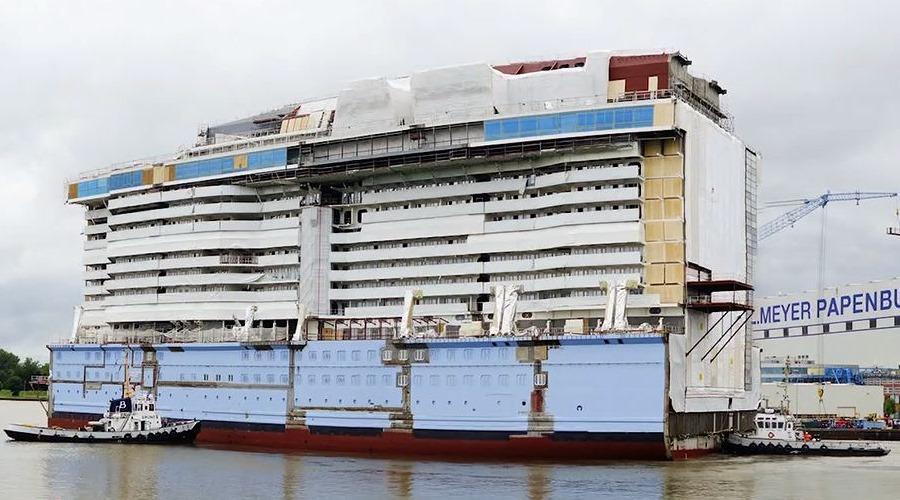
The ice-going cruise shipbuilding is so expensive as to hull strength and engine power, that the best option is to buy an unfinished vessel or to refit an existing Ice-class ship (often an ex-navy vessel), like the case of the Regent Seven Seas Navigator ship. Constructed as a naval support ship and strengthened for navigation in ice, the Navigator ship's hull was purchased from the former USSR (now Russia), while its superstructure was finished later at the T. Mariotti shipyards in Genoa, Italy.
The following YouTube timelapse video shows the Japan-made AIDAprima cruise ship construction process (shipyard Nagasaki Japan ). Next YouTube video shows the Aqua Mekong riverboat construction (time-lapse).
Cruise ship design
This is an amazingly detailed cruise ship design infographic showing what is what and where on a typical cruise passenger vessel. Note: Click on image to enlarge, backspace/back button to return to the article page.
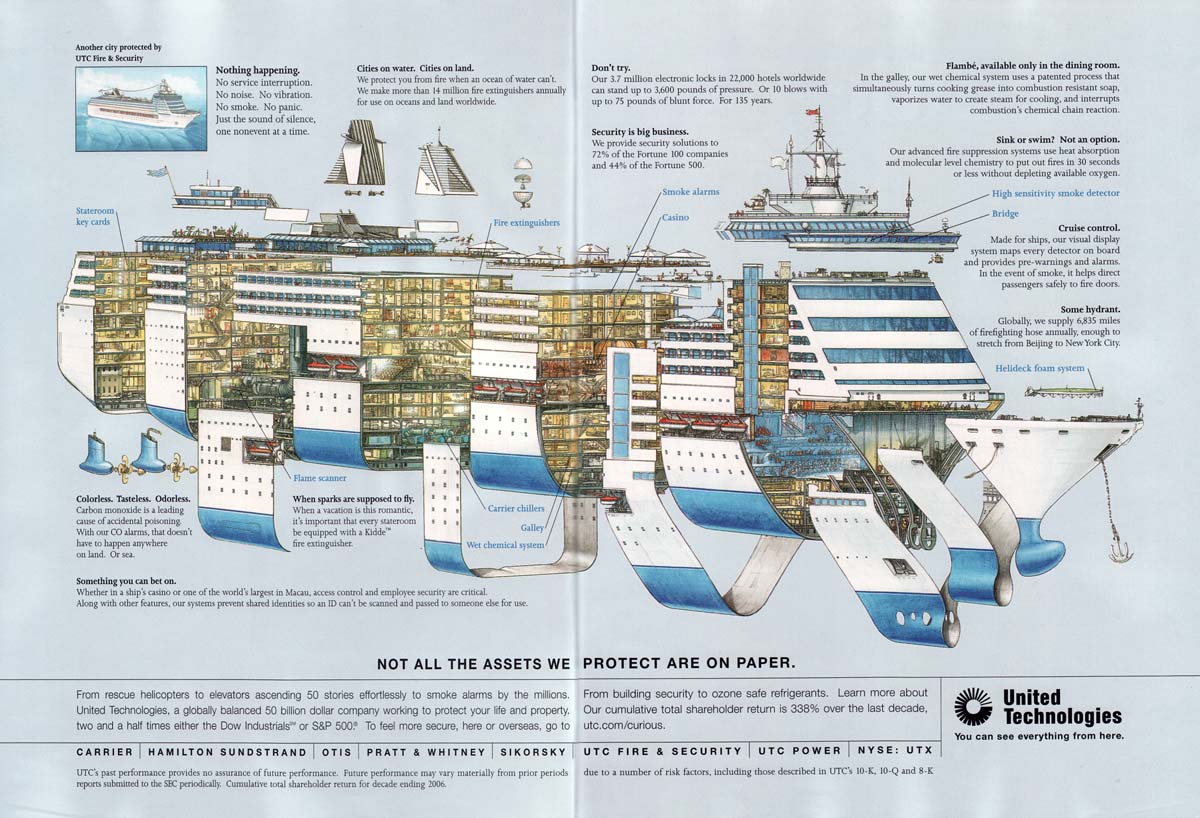
Marine design solutions for cruise ships are truly amazing and unique, using the latest innovations, technologies, and materials to ensure difference from other existing passenger ships. Special onboard features, such as the Royal Caribbean ships' rock-climbing walls, ice-skating rinks, surf simulators, wave pools, and the 9-deck high Zip-line are an irresistible temptation and a true allure for all the ship vacation fun fans. As to the common features, all big-capacity passenger ships have a several decks-high Atrium, at least 3 huge swimming pools, a Spa-Fitness complex, a grand casino, a library, duty-free shops, 2 huge capacity main restaurants, grand theatre, disco nightclub, kids and teen areas, numerous bars and lounges, and all-new big ships feature an open wraparound Promenade.
Cruise ship interior design
What about cruise ship interior designs? An example is SMC Design, which was appointed by Cunard Line to lead the development of the interior spaces on RMS Queen Mary 2 in preparation for liner's drydock refit in 2016. Cunard's flagship had a multi-million 25-day extensive refurbishment (May 27-June 21, 2016) that boasted new interior designs. The most iconic liner in the world opened the next chapter in her illustrious career. The announcement of the designer company followed the news that QM2 will gain 15 brand new single cabins and an additional 30 Britannia Club rooms during the refit. The popular onboard kennels were expanded in order to cater to the high demand this extraordinary facility already attracts.
SMC Design was established in 1994. The London -based design consultancy specializes in the maritime sector. SMC Design's team has worked on many cruise vessels - from small yachts to some of the biggest ships ever built. It also has a working history with Cunard liners, leading previous refits of QE2, Cunard Princess and Cunard Countess, while also being involved in its current fleet design: Queen Victoria , Queen Elizabeth and Queen Mary 2. Andy Collier, SMC Managing Director, was part of the launch design team of QM2 at the beginning of the Century. She was then the first Atlantic liner being built for more than 35 years.
New Russian cruise ship designs
In August 2016, at Lotus shipyard (Astrakhan, Russian) part of ASC (United Shipbuilding Company), the keel was laid for the 1st Russian passenger cruise ship in decades. Support for the new class of even vessel is coming from Russian Federation president Vladimir Putin, who expressed hope that this will be the first but not the last of a series of such ships.
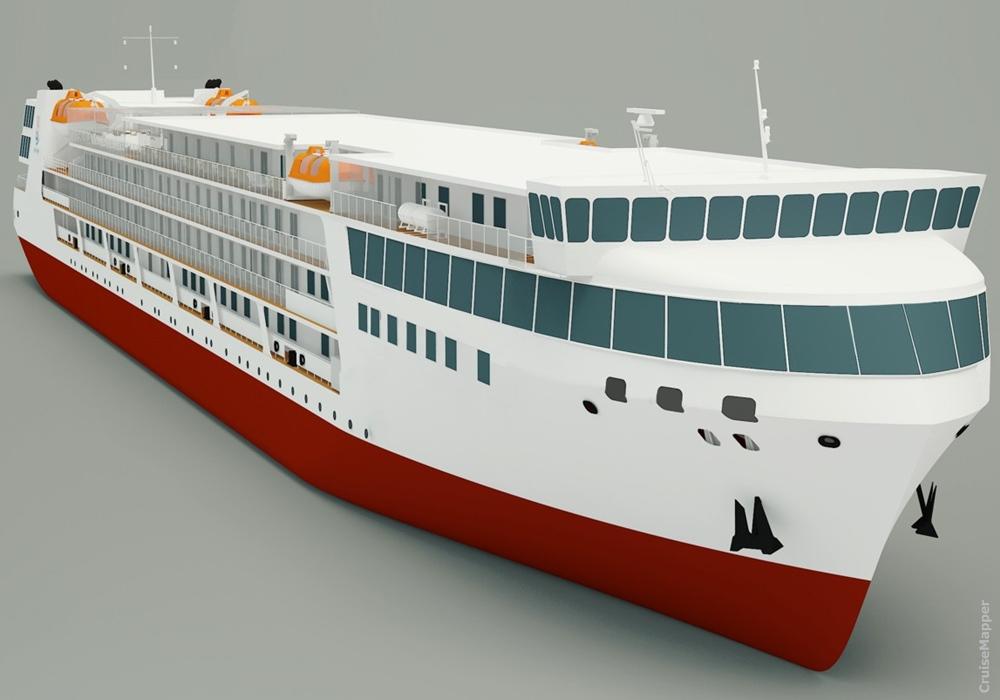
The Marine Engineering Bureau office engineers developed the Concept PV300VD cruise ship, the first of which is to be completed within 3 years. The project belongs to Saint Petersburg team of Marine Engineering Bureau SPb, which has been working in Russia for 16 years. Its other branch is in Odessa . Such vessels were not generally built in the old Soviet Union.
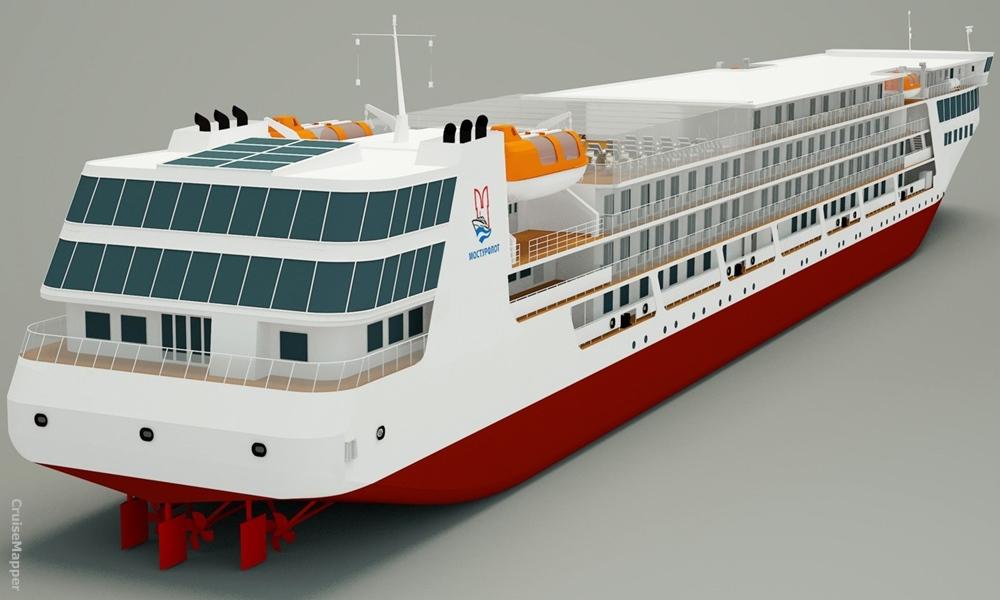
The last built in the USSR, 2 river cruise ships, Soviet Union and Lenin, were built at the Gorky plant in 1959-1960. Then, as with its ocean ships, the Soviet Union bought foreign-built river ships, until 1989-1990. However, these were not entirely foreign as they were created to Soviet order and developed for operation in Russian conditions. These vessels were built mainly in Austria, East Germany, and Czechoslovakia. After 1990, Russian riverboats were no longer built and the business was carried on for years utilizing old tonnage. The same happened with the Russian passenger fleet as they were banned in North America after Russia's invasion in Afghanistan.
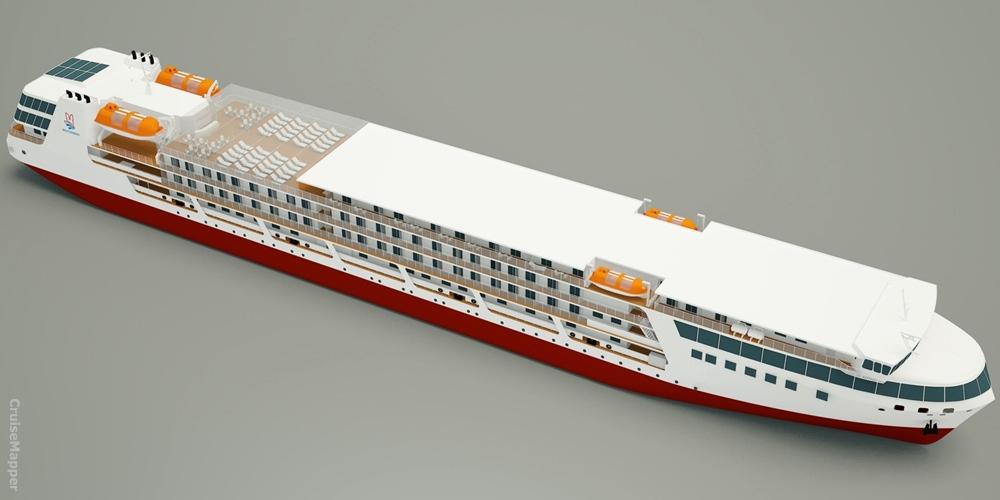
Today, shipping conditions in Russia are different. The new ships are planned to be "river-sea" ships. This class is needed in order to navigate large lakes. Russian river cruise ships are much more powerful than typical Danube and Rhine vessels. Dimensions for the new 310-passenger ships will be 463 x 55 feet. The PV300VD concept emerged in 2010-2015 by the order of the Russian Federal Marine Agency. The program's state customer and coordinator is the Minister of Industry and Trade, and completion is scheduled for 2019. The cost of a ship varies between 2.5 to 3.5 billion rubles and the payback period is 5 to 20 years. 3 such ships are foreseen at the stage, though more could follow. The next photo shows the design of Vodohod's new river cruise ship project PV300VD.
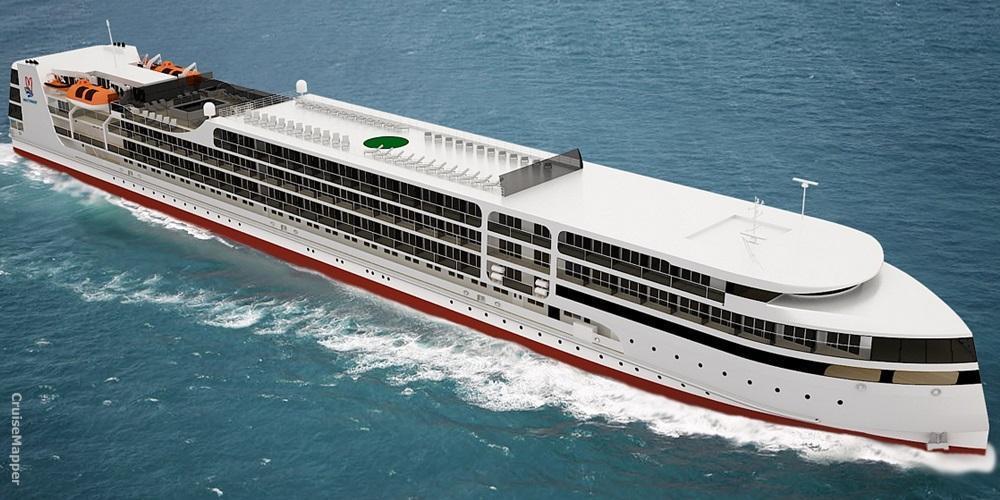
The next photo combo shows the design of Mosturflot's new river cruise ship project PV300.
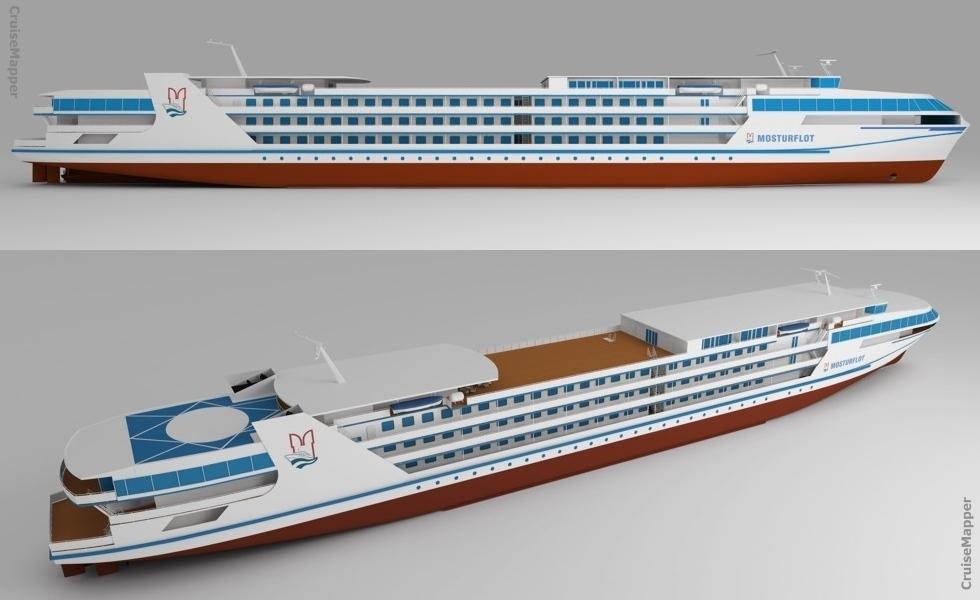
The routes foreseen for the new Russian ships are in season (May to October) between Moscow and Saint Petersburg, then taking travelers from Moscow to Samara and Rostov-on-Don, in the winter embarking in the Eastern Mediterranean and possibly the Red Sea: for example, Rostov-on-Don- Yalta- Odessa- Istanbul- Alexandria . There are talks about navigation in Crimea, Sevastopol, and Sochi, on more interesting routes in the Caspian sea.
The newbuilds could carry about 500,000 passengers annually, of which about 100,000 foreign tourists. The number of foreigners declined by nearly a half in 2014 as western tour operators cut Russian programs and westerners stayed away. According to the Ministry of Industry and trade, buyers of the new ship would be operators like Mosturflot (GK Sea and River shipping company), Vodohod and Orthodox. Given the high cost of the vessels, it is planned to lease them to operators. The main difference of this 4-deck ship is that it will be able to navigate not only rivers but seas as well. The vessels will also be more luxurious than past ships and will include western amenities, such as French balconies and comfortable large suites.
Next image shows a traditional European river cruise ship design (4-deck boat). All top-deck/sundeck structures (Wheelhouse, awnings, railings) are retractable and lowered when the boat passes under low bridges.
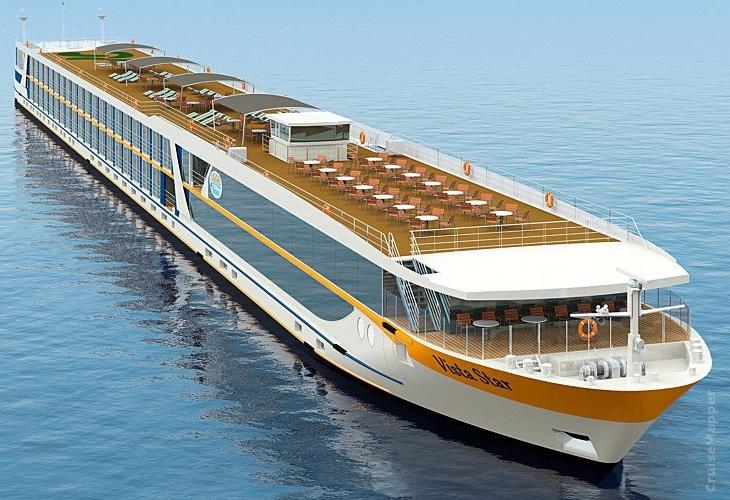
New expedition cruise ship designs
A new contract was awarded to the shipbuilder Uljanik (Croatia) for a 10,000-GT, 237-passenger ship ( Scenic Eclipse ) scheduled for delivery in 2018 but eventually postponed to 2019.
Based on these dimensions, the new ship was to be of the same general size as Ponant's fleet, the latest of which ( Le Lyrial ) was built at Fincantieri 's Shipyard Ancona Italy . Uljanik has not disclosed the identity of the purchaser, but new ships are also expected from Lindblad and Seabourn in 2018.
Next photos show other designs fitting the expedition vessel category.
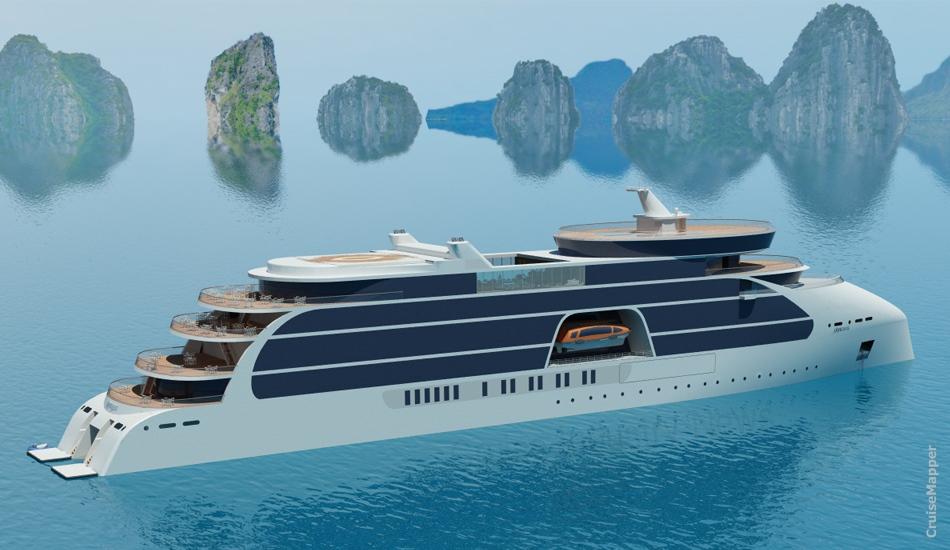
The above is STX France's Project Ulysseas (145 m length, 200 passengers) was officially revealed in March 2015.
Next is the 2020-announced icebreaking cruise ship design developed by Knud E. Hansen.
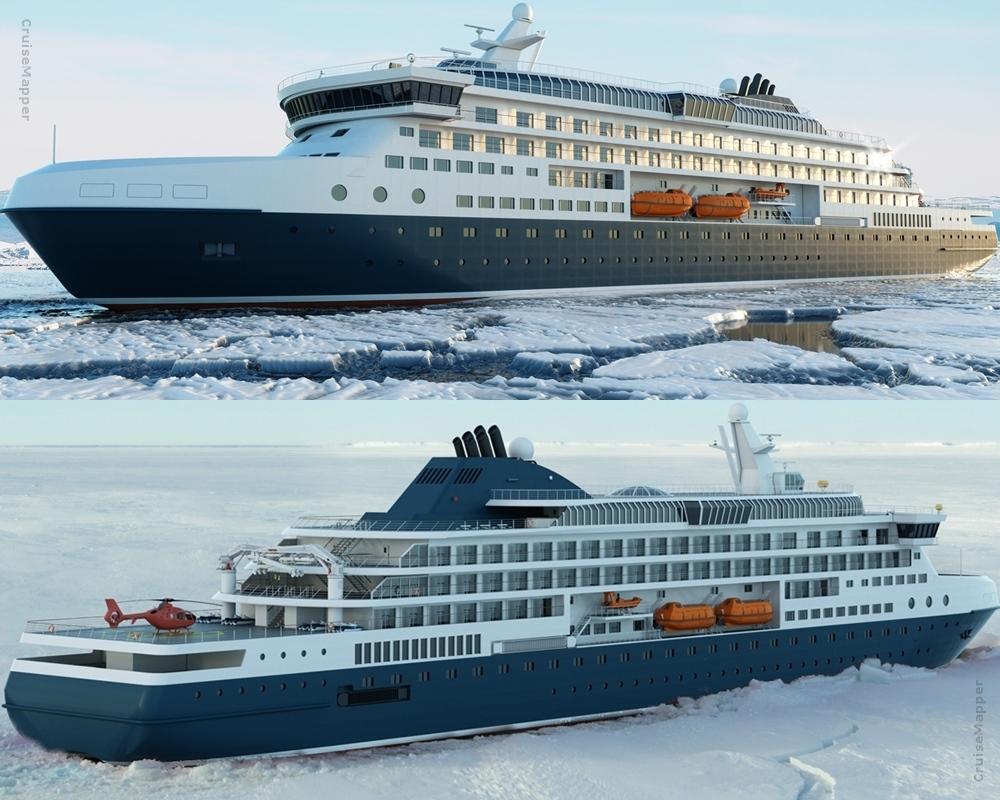
The PC3 ice-classed vessel has deadweight/DWT 1965 tons, LOA length 144 m, beam 22 m, draught 7 m, max passenger capacity 300 (plus 150 crew) and 150 staterooms. Most cabins are with step-out balconies and interconnecting, featuring the company's "Flex Cabin System" which allows their walls to be reconfigured in order to convert a Suite into two separate cabins.
The newbuild has max cruising speed 17 knots (20 mph / 32 kph), can operate in solid ice (max thickness 1,8 m) and has diesel-electric propulsion (based on 2 azipods, total power output 15 MW), 6 electricity generators (dual-fuel / LNG and MDO-diesel) plus a lithium-ion battery pack (powers the ship while docked). The new passenger ship design features an Ice Bar, multi-purpose Lounge, a tender garage (for Zodiacs and other expedition equipment that can be launched via a portside shell door), an aft-located helicopter deck (where a helicopter is lowered into the hanger on the below deck).
The next design (by Aker Arctic) is of an expedition ship ordered by the UK-based company Polar Cruise Enterprises Ltd. The vessel has LOA length of 135.5 m, Beam 17.8 m, Draught 5.5 m, Propulsion 2x 3.5 MW azimuth thrusters, Engines 4x MAK 6M32C (2,88 MW each) allowing max cruising speed 13 knots (15 mph / 24 kph).
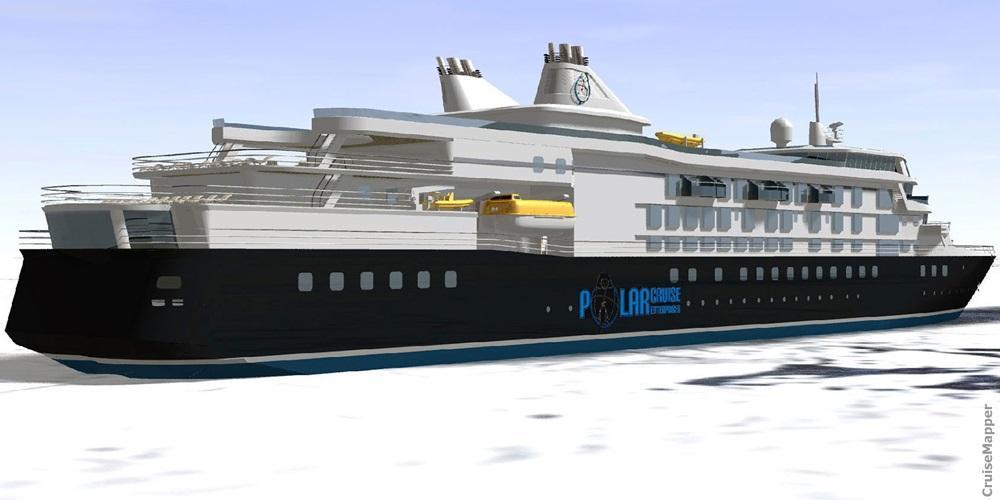
Knud E Hansen's expedition ship design is with 150 staterooms and heavy-duty, ice-rated hull.
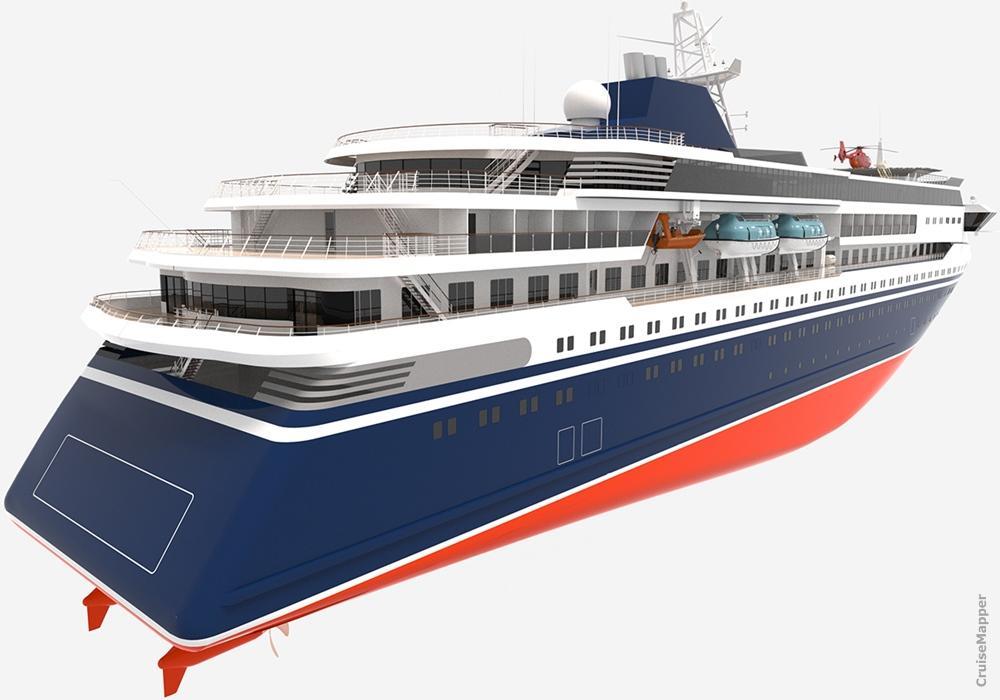
The next video shows various passenger and research ship designs developed by Knud E Hansen (Danish marine engineering company established in 1937).
Next is the VARD-6 polar ship design on which are based the newbuilds of Ponant (Explorers-series), Hapag-Lloyd (Hanseatic-series), Viking Expeditions and Coral Expeditions (Australia).
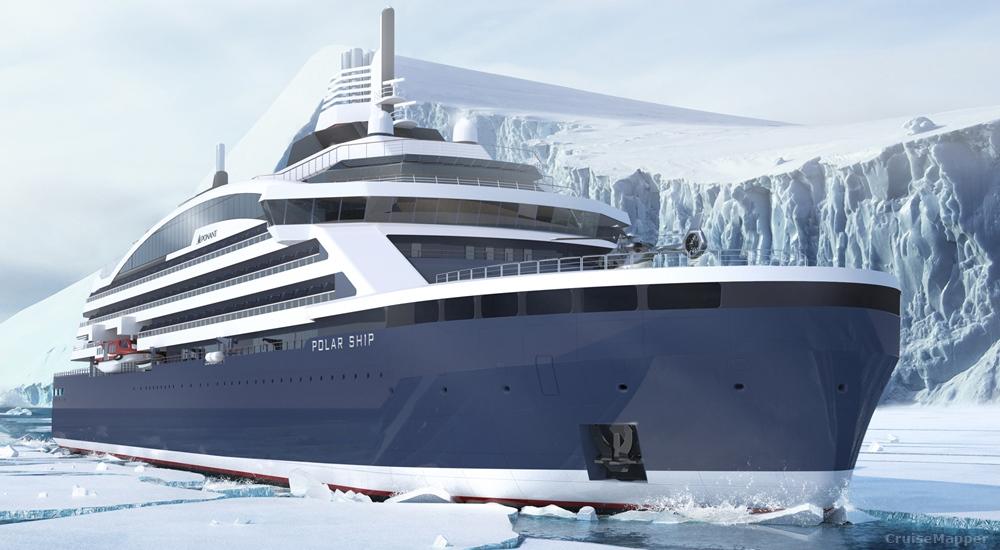
Next images show expedition yacht cruise ship design by the Dutch shipbuilder Damen Group. The vessel is "Polar Class 6" (with ice-strengthened hull) and has endurance 30 days autonomous cruising.
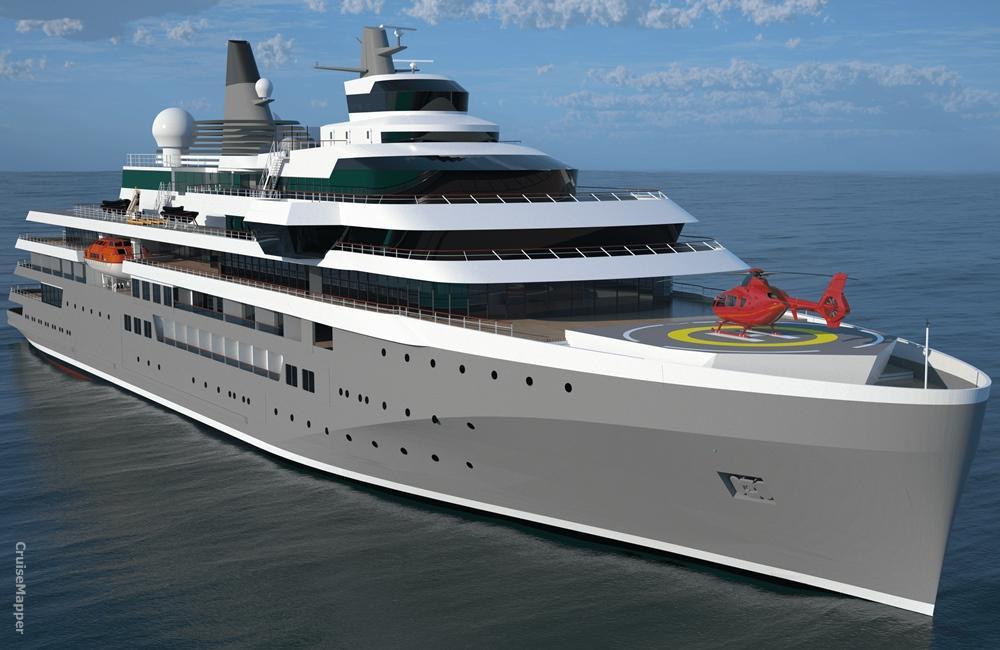
The ship has approx 1100 m2 public space and 2500 m2 outdoor deck space. Max capacity is 115 passengers. Propulsion is a diesel-mechanical hybrid and encompasses IMO Tier 3 compliant medium speed engines.
Damen Shipyards new expedition cruise ship design
Damen's cruise vessel is "battery ready", which means it could be equipped with a battery system for peak-shaving (reducing peak demand), providing supplementary power for maneuvering or silent drive operations. The hybrid propulsion is the best fuel-efficient technology currently available, allowing service speed 16 knots (30 kph / 18 mph) and max speed 18 knots (33 kph / 21 mph). The next aft view image also shows the ship's marina platform.
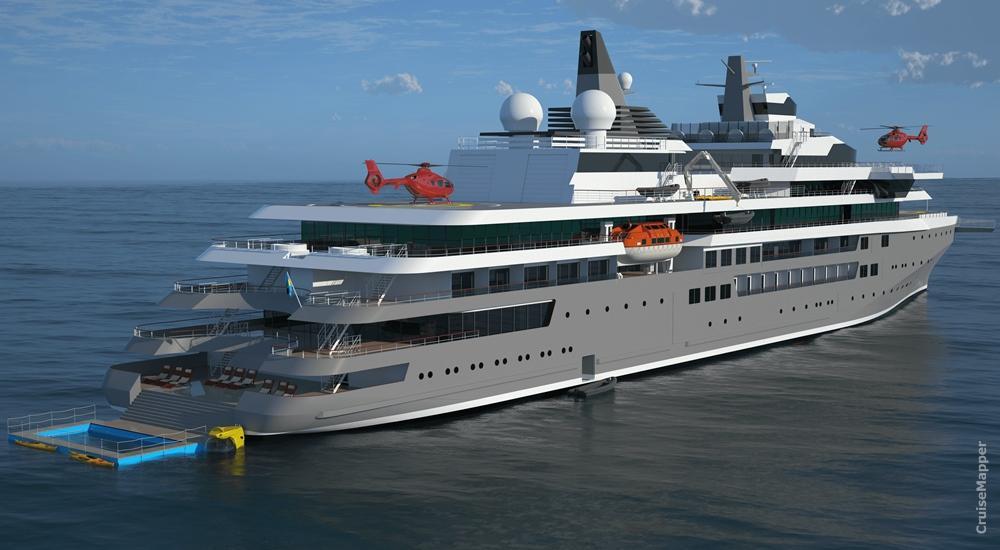
SunStone's "World-Class" expedition cruise ship design
On March 16, 2017, SunStone Ships Inc (USA) signed an agreement with the Hong Kong-based "China Merchants Industry Holdings" (CMIH) for the construction of 4 units based on the "ULSTEIN CX103" design. SunStone is currently the world's largest (by GT tonnage) shipowner chartering exclusively expedition vessels to the cruise travel industry. The contract included the option for additional 6 units.
The ice-class 1A vessel has the following polar code specifications.
- Designer: SUNSTONE SHIPS INC
- Shipbuilder: (CMIH) CHINA MERCHANTS INDUSTRY HOLDINGS
- Passenger cabins: 80-95
- LOA Length: 104 m
- Beam / Width: 18 m
- Speed: 15 Kn / 17 mph / 28 kph
- Ice-Class: 1A
- Polar Class: PC 6 (highest)
The boat has a fleet of Zodiacs (20-22x aft-stored inflatable RIB boats) and features a dedicated Zodiac loading platform for easy boarding.
Charterers of these ships are the travel brand companies AQV-American Queen Voyages , Aurora Expeditions ( fleet ), Albatros Expeditions ( fleet ).
STX France "Ulysseas" cruise ship project
In March 2015, the major shipbuilder STX France unveiled a revolutionary new expedition ship design named "Ulysseas". It represents an innovative idea for a small cruise ship ( passenger capacity 200, ice-class hull, length 476 ft / 145 m, cruising speed 17 Kn / 20 mph / 31 kph) aimed at the expedition cruising market.
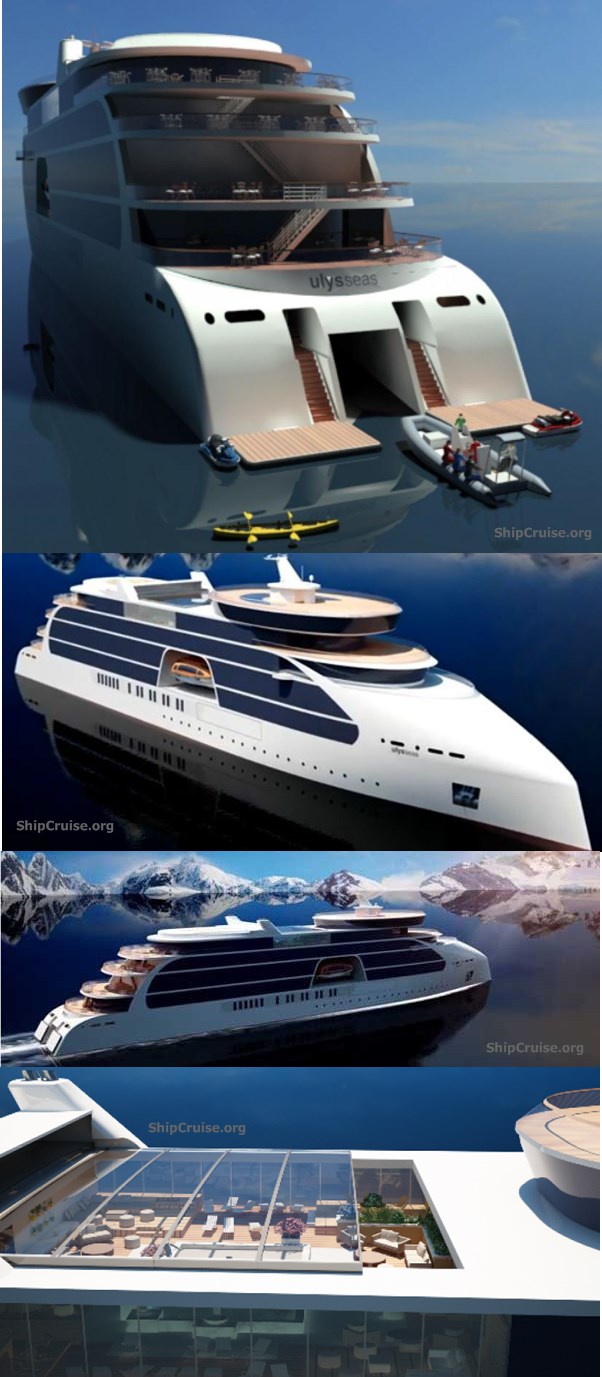
The main reason for the Ulysseas project is that currently, the expedition cruise market uses mostly second-hand vessels. Unique for this new ship design is the excessive usage of glass (in all public areas) and the French balconies (false balconies) on all passenger cabins. Every passenger-use facility on the new vessel features floor-ceiling windows. There will be a unique forward-located observation lounge for 360-degree views.
The Ulysseas ship's aft-section is an STX-patented design for saving energy. This is a movable duck-tail, which position depends on cruising speeds and weather conditions. The vessel is powered by two 2,5 MWT azipods (360-degree rotating thrusters), with 4x diesel-electric generators and 1x scrubber. This cruise ship design also features a helipad (helicopter landing pad), a helicopter storage space (inside the ship), zodiac boats for ship-to-shore operations.
(2018) "Silenseas" sailing cruise ship design by Chantiers de l’Atlantique (fka STX FRANCE)
In early March 2018, STX France revealed a carbon-free cruise vessel design (trademarked Silenseas) using wind as main power source. The new wind-power technology was trialed on Ponant 's yacht Le Ponant , on which one of the existing sails was replaced and the new technology tested.
STX France's project was something never done before. The carbon-free sailship design is an alternative to the popular hybrid-powered vessels. Hydrogen and fuel cells are still expensive, plus hydrogen is not available in most ports.
The technology uses the company's patented "SolidSail" concept. The sails (total size up to 1200 m2 / 12900 ft2) are mounted on masts but without any ropes or cables. The STX France design has 3 masts and 3 rigs, with masts rotating in order to adapt the sails to the wind. The new design also includes the latest hybrid propulsion technologies, combining wind with LNG, and potentially batteries, solar panels, and fuel cells.
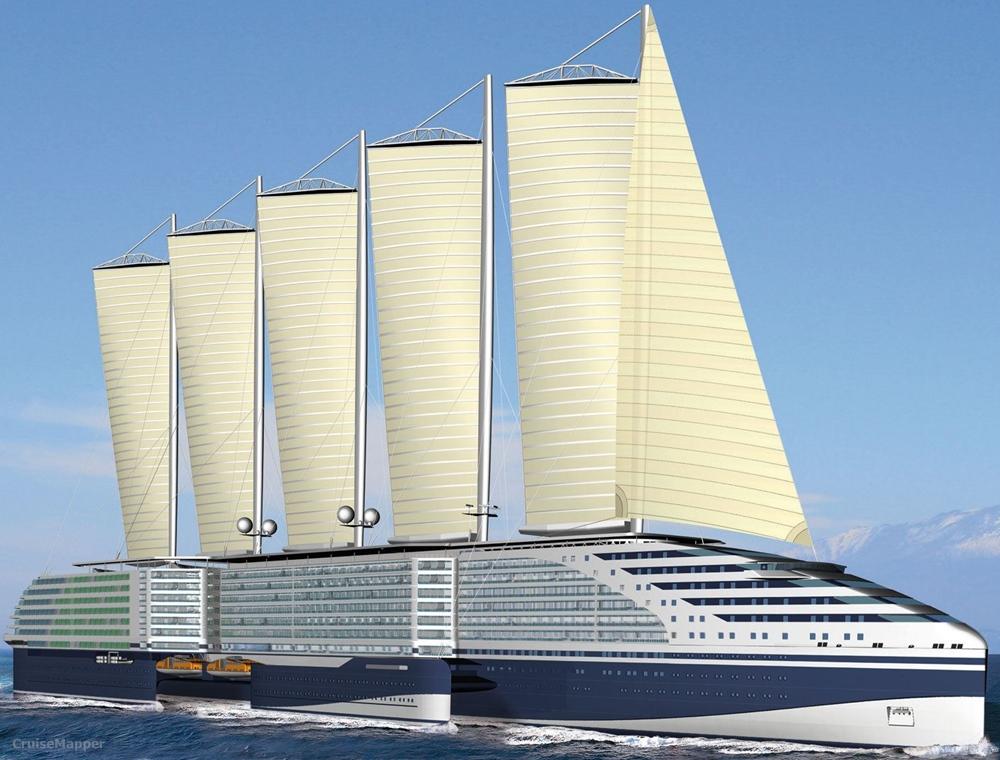
The sailing ship can reach speeds of 12 knots (14 mph / 22 kph) under sail in 15 knots (17 mph / 28 kph) winds. In winds over 15 knots, the vessel's propellers will be used, acting as a turbine that draws power from the sails. On Caribbean Sea routes, the new technology could reduce propulsion energy by 60%.
STX France's sailship design was developed for 3 vessel sizes, the biggest being 15000 GT-ton with LOA length 190 m (620 ft) and 150 passenger staterooms. The French shipbuilding company started research in sail propulsion in 2009, Silenseas has technology patents (2009 and 2017) for the new sail. The unit is made from fiberglass, carbon and epoxy-resin panels.
SolidSail system debuted on October 31, 2018, on the yacht Le Ponant. The new Solid Sail (sized 300+ m2) was constructed at Chantiers de L'Atlantique ( Saint-Nazaire ) and installed in Marseille . The 3-masted Le Ponant departed from France to Cape Verde Islands, then embarked on a Transatlantic crossing to Cuba, testing the new sail for 1 year.
Similar is the concept of Peace Boat's new vessel Ecoship (built by Arctech Helsinki Shipyard in Helsinki, Finland ).
In December 2022 was announced the shipyard's first SolidSail with a carbon-fiber mast. The project was a collaboration with the Lorient -based companies Lorima (manufacturer of carbon fiber masts and spars), Avel Robotics (manufacturer of composite parts), CDK Technologies (boat building company) and Mulitplast ( Vannes -based shipbuilding company).
The carbon-fiber SolidSail mast has height 66 m/217 ft, width 2 m/7 ft and weight ~20 tons. It can carry a SolidSail sized ~1500 m2/16150 ft2.
Silenseas' SolidSail will propel the world's largest wind-powered/sailing cruise vessel - Accor's Orient Express Corinthian/fka Silenseas (2026).
Aeoldrive (rig comprising the mast and the SolidSail) is fully automated and 360-degree rotating, while the masts rotate/tilt up to 70 degrees (when the vessel passes under bridges).
(2019) "Wind Cruise Vessel" design by KNUD HANSEN
On June 19, 2019, KNUD HANSEN announced its medium-sized (LOA length 110,3 m / 361 ft) long "Wind Cruise Vessel" design. This sail-assisted ship has max passenger capacity 100, max speed 15 Kn (17 mph / 28 kph), operational range 6000 nm (6900 ml / 11100 km), draught 4,5 m (), TDW-deadweight tonnage 730 tons. The new sail-ship targets the expedition travel market and passengers who prefer destinations inaccessible by larger vessels.
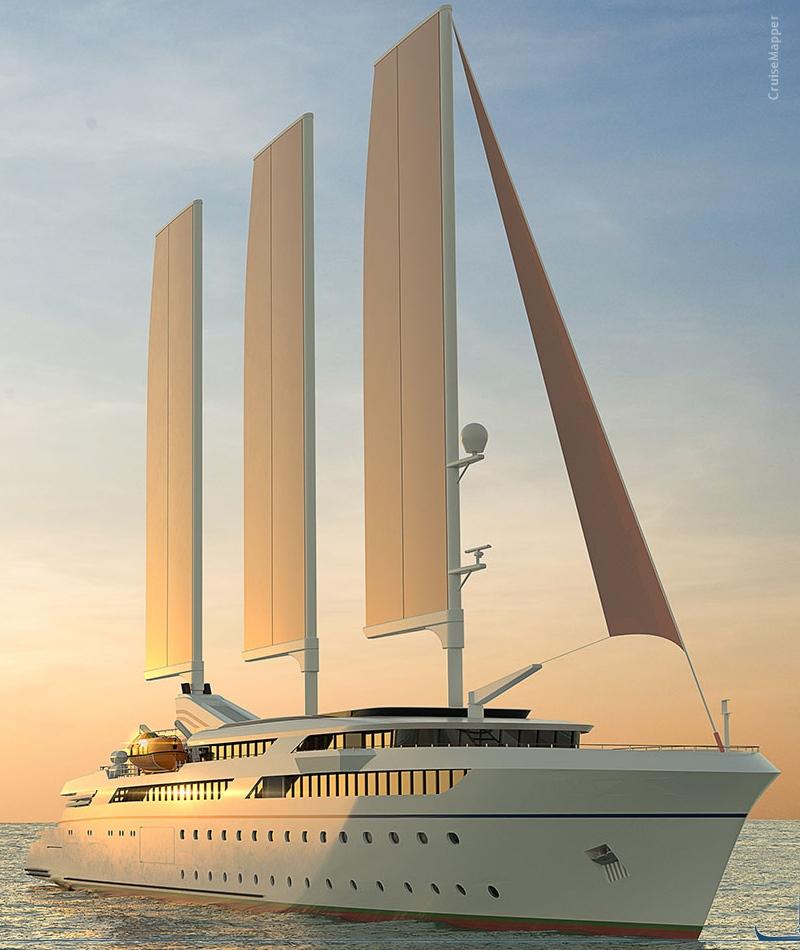
The vessel is powered by 4x low-sulfur ULSD diesel engines (plus wind power) and also includes a large battery pack (for zero emissions while in port and protected marine zones). The rig is designed by Detlev Loll Ingenieurburo GmbH ( Peenemunde -based company) and comprised of 3x free-standing masts. Each mast is fitted with a fully-battened sail with adjustable flaps (wing devices that increase the max lift coefficient that a wing can generate). Ship's total sail area is 1910 m2 (20260 ft2). The sails are computer-controlled and designed for peak performance even in light winds.
The propulsion system is based on aft-located twin-screw propellers (fixed) and two fore-located tunnel thrusters (for better maneuverability in ports and anchorages). In sail-assisted mode, two fin stabilizers limit the ship's heel/listing to just 6 degrees.
Cabin decks house 48 passenger staterooms (46 cabins plus 2 suites) - all outside and many with balconies. Sea Lounge features underwater porthole windows. Deck 2 has a large tender boat garage for Zodiacs (rigid inflatable boats), jet skis, scuba diving gear, and other equipment. The ROV (remotely operated underwater vehicle) is fitted with HD camera equipment underwater observations at max depth 3 km ()9840 ft). Deck 3 is the Sun Deck featuring a swim platform with a ladder for easy water access. On Deck 4 are the restaurant (with outdoor terrace), bar, library, card room. On Deck 5 are the aft-located bar lounge and the bow-located observation area. Deck 6 has an open-air cafe and sun deck (sunbathing area with deckchairs and loungers).
Cruise ship building vs ship refurbishments
Unlike the scheduled cruise ship refurbishments , major refits may include even a cruise ship lengthening, like in the case of Royal Caribbean ship Enchantment of the Seas lengthened in 2005 (see the photo below). The Enchantment ship lengthening cost ~ US$55 million, it was a process of cutting the ship in two and inserting a whole new 73 ft (22 m) 3,500 tons midsection, pre-built at the Aker Finnyards.
The month-long dry-dock at the Keppel Verolme shipyards (Rotterdam, The Netherlands) resulted in adding 151 brand new cabins, a 50% bigger Pool Deck area, a new kids area, a teen centre, several new bars and lounges, an expanded main dining room, a new specialty restaurant. This "refurbishment cost" record was recently beaten by the CCL line and the US$155 million Carnival Destiny refit 2013 producing a brand new ship named Carnival Sunshine!
The average cost of building a cruise ship is around the US $450 for mid-sized vessels and up to $800 million for bigger cruise ships. These prices, along with the current economy status force many cruise lines to hold off from building new ships - the biggest expense of all. As a rule, all new cruise ships on order/currently under construction are by contracts signed years ago when the dollar had a good rate.
Cruise shipbuilding prices are high enough to not meet the return requirement. Even the mighty Carnival Corporation (the world's largest cruise shipowner) puts its shipbuilding plans on hold. Royal Caribbean is one of the few companies continuing to place orders for new ships - and not any ships, but the ever largest, the most innovative, the most expensive in the world. Still, most passenger ship lines are trying to keep their current fleet fresh and good looking. Two of the best examples are Holland America with its $450 million SOE program for ship renovations, and Carnival investing $250+ million to fully refit and refurbish 8 of its oldest vessels.
The next photo shows the construction of the world's largest cruise ship - Harmony of the Seas - at Saint-Nazaire (STX France) .
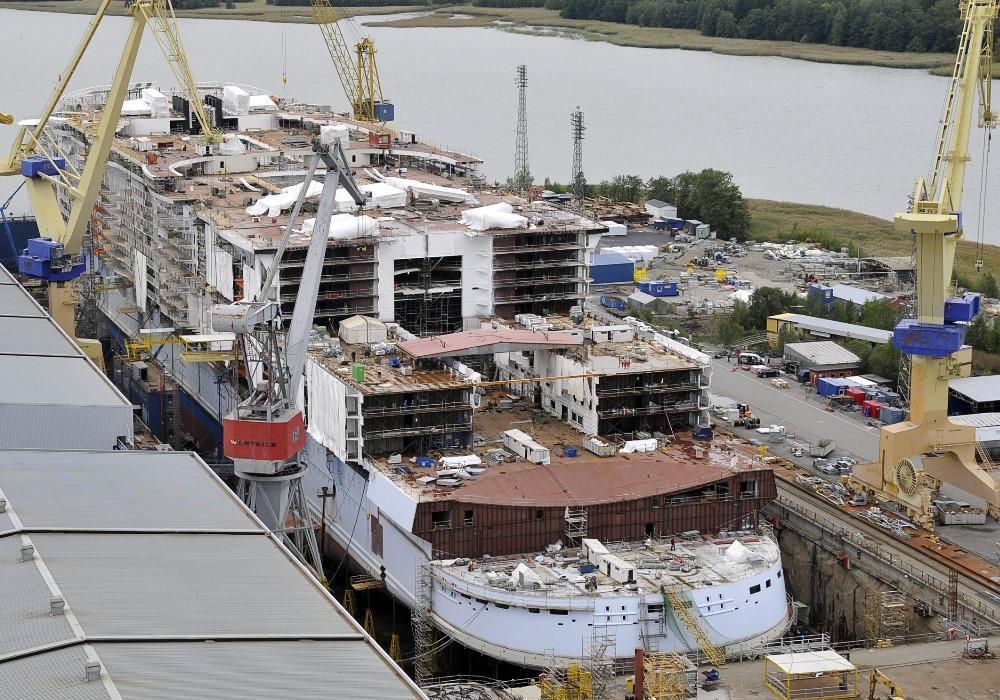
The following tag link lists all of CruiseMapper's news related to shipbuilding .
Streets of Monaco Superyacht
"Streets of Monaco Superyacht" is a futuristic project developed by Yacht Island Design. The vessel is modeled after the actual city and designed for billionaires to sail and play.
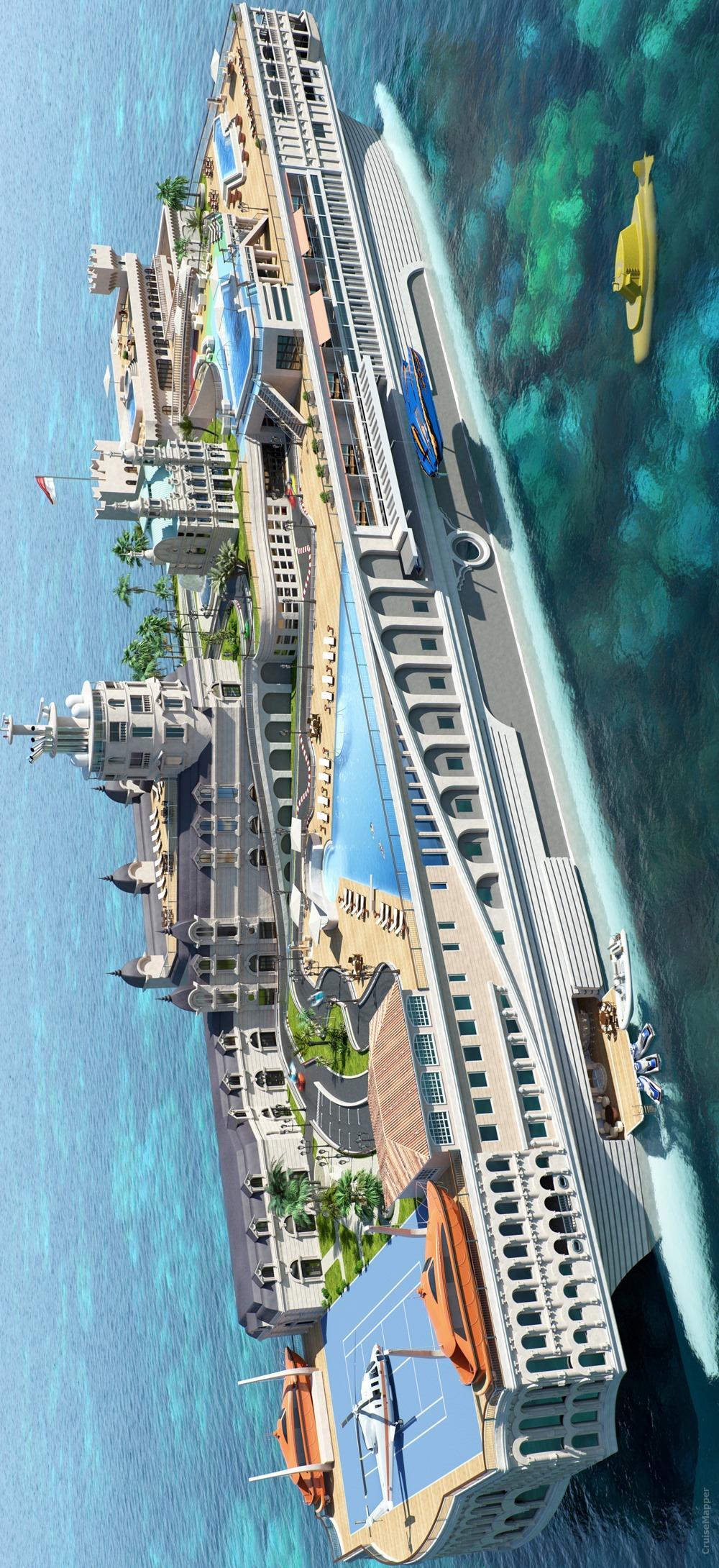
The 500-ft / 152-metre-long ship is lined with scaled-down versions of Monte Carlo's most famous buildings, including the Casino and its Grand Prix course (which on the yacht doubles as go-kart course). Among the most prominent amenities on this superyacht are swimming pools, cafes, full-service spa, full-size sports court (doubles as a helipad for private helicopters), library, interior parking for smaller boats, mini-submarine.
Staterooms (1VIP Suites) are sized 3800 ft2 (350 m2) each. There are also cabins for the 70 crew and staff members. The Superyacht cost about USD 1 billion.
Havyard's sightseeing cruise vessel design
In July 2019, Havyard Group ASA (Fosnavag Norway-based ship technology company) and SINTEF ( Trondheim Norway -based research company) started a project for designing a new environmentally friendly sightseeing cruise vessel specifically for touring the Norwegian Fjords, as well as a new Norwegian Coastal cruiseferry design. The project includes measuring energy consumption, hull optimization, developing new-generation equipment and using renewable energy sources.
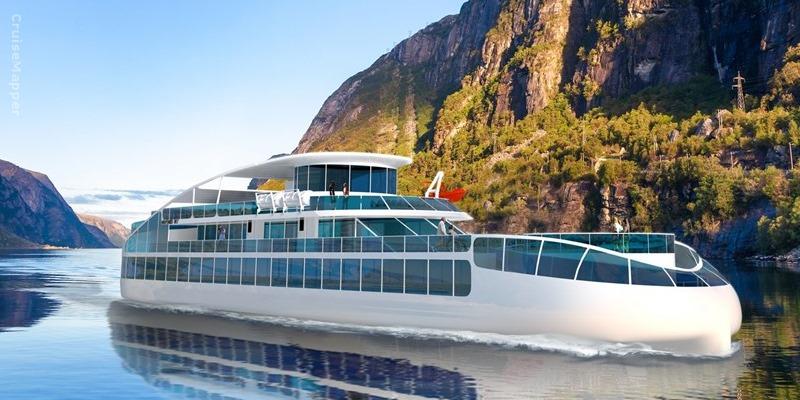
These ships are designed with battery-power propulsion (zero-emission) and recharging in call port. The vessel has LOA length is 70 m (230 ft), max passenger capacity between 600-800, max speed 10-11 knots (20 kph / 13 mph), floor-ceiling and wall-to-wall windows throughout (for unobstructed fjord cruising experiences), wheelchair-friendly interior and exterior spaces. The new vessel's designer is Stig Magne Espeseth.
Passenger embarkations/debarkations are at floating hubs (platforms at sea) installed at the fjord's mouth and outside the itinerary's seaports. The hubs also double as charging stations for the smaller-sized vessels.
Winter is here! Check out the winter wonderlands at these 5 amazing winter destinations in Montana
- Plan Your Trip
How Do Cruise Ships Work
Published: December 16, 2023
Modified: December 28, 2023
by Steffane Moss
- Sustainability
Introduction
When it comes to the ultimate vacation experience, cruise ships offer a unique and exhilarating adventure on the high seas. These floating resorts provide a wide range of amenities, entertainment options, and destinations, making them a popular choice for travelers of all ages. But have you ever wondered how cruise ships actually work?
In this article, we will delve into the fascinating world of cruise ships and explore their history, design, operations, and impact on the environment. From the moment you step onboard to the intricate workings behind the scenes, you will gain a deeper understanding of what makes a cruise ship a marvel of engineering and hospitality.
Cruise ships have a rich and storied history, dating back to the 19th century when steamships first began offering leisure voyages. Over time, they have evolved into the mammoth vessels we see today, capable of carrying thousands of passengers and crew members.
These floating cities are meticulously designed and structured to ensure a smooth and enjoyable experience for guests. From luxurious accommodations to diverse dining options, entertainment venues, and recreational facilities, cruise ships offer an array of amenities that cater to all tastes and preferences.
Behind the scenes, a dedicated crew works tirelessly to keep the ship running smoothly and attend to the needs of the passengers. From the captain and officers responsible for navigation to the housekeeping staff, entertainers, and culinary teams, each member plays a crucial role in creating a memorable and seamless experience for guests.
While the primary purpose of a cruise ship is to provide vacationers with a delightful experience, safety is of paramount importance. Advanced navigation systems, extensive training programs, and strict safety protocols ensure that passengers are in capable hands throughout their voyage.
However, as the popularity of cruise ships continues to rise, so does the concern over their impact on the environment. Efforts are being made to reduce emissions, minimize waste, and adopt sustainable practices to preserve the delicate ecosystems they visit.
In the following sections, we will delve deeper into these topics, exploring the history of cruise ships, their design and structure, propulsion systems, onboard facilities and amenities, crew and staff, navigation and safety measures, cruise ship operations, and environmental impact and sustainability efforts.
So, grab your virtual boarding pass and join us on this journey as we unravel the mysteries of how cruise ships work.
History of Cruise Ships
The roots of cruise ships can be traced back to the 19th century when ocean travel started to become more accessible and appealing to the general public. While early voyages were primarily focused on transportation, the concept of leisure cruising soon emerged, offering travelers a unique and luxurious vacation experience.
Steamships played a significant role in the development of the modern cruise ship industry. In 1818, the Black Ball Line, an American shipping company, became the first to offer regularly scheduled passenger service across the Atlantic Ocean. This marked the beginning of the era of transatlantic crossings, where steam-powered ships provided a comfortable and efficient means of travel.
As leisure travel gained popularity, companies like Cunard Line and White Star Line introduced luxurious ocean liners that catered to the elite. These grand vessels featured lavish accommodations, elegant dining rooms, and onboard entertainment, providing a glamorous experience for the wealthy and well-heeled.
In 1900, the German shipping company Hamburg-America Line launched the first dedicated cruise ship, the Prinzessin Victoria Luise. This vessel was specifically designed for pleasure cruising, offering amenities such as a swimming pool, a gymnasium, and even a winter garden. With its maiden voyage, the era of cruise ships truly began.
However, it was not until the mid-20th century that the modern concept of cruising took shape. With the advent of commercial air travel, the focus shifted from transatlantic crossings to cruise vacations. Companies like Norwegian Caribbean Line (now known as Norwegian Cruise Line), Carnival Cruise Line, and Royal Caribbean International built larger and more innovative ships to meet the growing demand for leisure cruises.
By the 1970s, the boom in cruising brought about a new generation of vessels, known as mega-ships. These massive floating resorts could carry thousands of passengers and offered an array of amenities, including multiple restaurants, theaters, casinos, and even water parks.
In recent years, cruise lines have continued to push the boundaries of innovation. They have introduced features such as onboard surfing simulators, go-kart tracks, and even robotic bartenders, redefining the concept of a modern cruise vacation.
Today, the cruise ship industry is a global phenomenon, with numerous companies operating fleets of ships that sail to destinations all over the world. From short weekend getaways to extended voyages that encompass multiple continents, there is a cruise for everyone.
As technology advances and travelers’ preferences evolve, the future of cruise ships looks promising. From eco-friendly propulsion systems and sustainable practices to advancements in onboard entertainment and amenities, cruise ships continue to innovate and provide unforgettable experiences for passengers.
Types of Cruise Ships
Cruise ships come in a variety of sizes and styles, each designed to cater to different types of travelers and offer unique experiences. From small expedition vessels to sprawling mega-ships, there is a cruise ship to suit every preference and budget.
1. Expedition Cruise Ships: These smaller ships are designed to navigate remote and challenging waters, such as the Arctic or Antarctic regions. With their reinforced hulls and ice-breaking capabilities, they allow passengers to explore untouched landscapes and observe incredible wildlife up close. Expedition cruises often offer educational programs and expert-led excursions to enhance the experience.
2. River Cruise Ships: Unlike ocean-going cruise ships, river cruise ships navigate scenic rivers and waterways, offering a more intimate and immersive experience. These vessels are smaller in size and typically have fewer amenities but provide a chance to explore picturesque cities, towns, and landscapes along the way. River cruises are popular in regions like Europe, the Nile River in Egypt, and the Mekong River in Southeast Asia.
3. Luxury Cruise Ships: Luxury cruise ships cater to discerning travelers who seek the highest levels of service, elegance, and comfort. These ships feature opulent accommodations, gourmet dining options, and a wide range of personalized services and amenities. Luxury cruise lines like Regent Seven Seas, Seabourn Cruise Line, and Silversea Cruises offer all-inclusive experiences for a truly indulgent vacation.
4. Mega-Ships: These are the giants of the cruise ship world, capable of carrying thousands of passengers. Mega-ships offer a plethora of entertainment options, including theaters, casinos, water parks, shopping arcades, and multiple dining venues. Cruise lines such as Royal Caribbean International, Norwegian Cruise Line, and Carnival Cruise Line are known for their mega-ships, which provide a wide range of activities and amenities for guests of all ages.
5. Boutique Cruise Ships: These smaller ships provide a more intimate and personalized experience for passengers. With a limited number of cabins, these ships offer a sense of exclusivity and often visit off-the-beaten-path destinations that larger vessels cannot access. Boutique cruise lines like Azamara Club Cruises and Windstar Cruises focus on creating a more immersive and culturally enriching experience for their guests.
6. Theme Cruise Ships: These specialized ships cater to specific interests and hobbies, offering a unique experience that goes beyond the typical cruise vacation. Examples include music-themed cruises, culinary cruises, wellness retreats, and even cruises focused on specific hobbies like photography or quilting. Theme cruises provide a chance to connect with like-minded individuals and indulge in activities related to your passion.
Whether you prefer an adventurous expedition through remote lands, a luxurious and pampering escape, or a fun-filled family vacation on a mega-ship, the wide array of cruise ship options ensures that there is a perfect fit for every traveler. The choice ultimately depends on your preferences, desired destinations, and the experience you seek on your cruise journey.
Design and Structure of Cruise Ships
Designing a cruise ship is a complex process that involves a careful balance of aesthetics, functionality, and safety. The structure of a cruise ship must be designed to withstand the rigors of the open sea while providing a comfortable and enjoyable experience for passengers.
At its core, a cruise ship is a floating city. Architects, naval engineers, and interior designers work together to create a vessel that maximizes space efficiency and embraces innovative design concepts. The exterior design is often sleek and visually striking, with different ships featuring unique profiles and color schemes that reflect the brand identity of the cruise line.
The structure of a cruise ship is typically divided into several decks. These decks house various public spaces, cabins, and amenities, creating a multi-level environment for passengers to explore. From elegant atriums and grand lobbies to spacious theaters, restaurants, and lounges, each deck is carefully planned to create a seamless flow of movement and ensure easy access to different areas of the ship.
One of the key considerations in cruise ship design is maximizing ocean views. Most cabins and public areas are positioned to offer stunning vistas of the sea, whether through large windows, balconies, or outdoor decks. This allows passengers to connect with the natural beauty of their surroundings and enhances the overall experience of being at sea.
To ensure stability and safety, cruise ships are equipped with advanced stabilization systems. These systems use various technologies, such as hydraulic stabilizers and ballast tanks, to minimize the motion of the ship and provide a smooth sailing experience even in rough seas. Additionally, double-hull construction and reinforced bulkheads enhance the ship’s structural integrity and ensure the safety of passengers and crew.
Another crucial aspect of cruise ship design is the incorporation of a wide range of amenities and facilities. From swimming pools and spas to fitness centers, casinos, theaters, and specialty restaurants, cruise ships offer a plethora of entertainment options for passengers to enjoy. Additionally, modern cruise ships often feature onboard activities such as rock climbing walls, water slides, miniature golf courses, and even virtual reality experiences to cater to a diverse range of interests.
The interior design of a cruise ship is carefully curated to create a welcoming and visually appealing environment. Attention is given to color schemes, lighting, and the use of space to evoke a sense of luxury and comfort. From elegant ballrooms and intimate lounges to cozy cabins and stylish dining venues, every area of the ship is designed with both aesthetics and functionality in mind.
Cruise ship designers also prioritize energy efficiency and eco-friendly practices. The implementation of energy-efficient lighting, waste management systems, and advanced air conditioning systems helps reduce the ship’s environmental impact. Some modern cruise ships even incorporate solar panels and utilize alternative fuel sources to further minimize their carbon footprint.
Overall, the design and structure of a cruise ship blend form and function. From the striking exterior to the thoughtfully planned interior spaces, every aspect is meticulously crafted to create a comfortable, safe, and visually appealing environment for passengers to enjoy their cruise vacation.
Propulsion Systems
The propulsion system of a cruise ship is responsible for powering the vessel and allowing it to navigate through the open waters. Cruise ships use a variety of propulsion systems, each with its own advantages and considerations.
1. Diesel-Electric Propulsion: Most modern cruise ships utilize diesel-electric propulsion systems. These systems consist of diesel engines that generate electricity, which is then used to power electric motors that drive the ship’s propellers. Diesel-electric propulsion offers excellent fuel efficiency, flexibility in power distribution, and reduced vibrations and noise levels onboard. Additionally, it allows for better maneuverability and enables the ship to operate efficiently at different speeds.
2. Gas Turbine Propulsion: Gas turbine propulsion is another type of propulsion system used in some cruise ships. Gas turbines are essentially jet engines that generate thrust by burning fuel and using the exhaust gases to power a turbine. This system provides high power output and allows for quick acceleration, making it ideal for faster cruise ships. However, gas turbines are less fuel-efficient than diesel-electric systems and produce higher emissions.
3. LNG Propulsion: A growing trend in the cruise industry is the use of LNG (liquefied natural gas) as a fuel source. LNG is a cleaner-burning fuel compared to traditional marine fuels, resulting in lower emissions of sulfur oxide, nitrogen oxide, and particulate matter. Cruise ships equipped with LNG propulsion systems can reduce their environmental impact significantly. LNG-powered cruise ships utilize dual-fuel engines that can operate on both LNG and marine diesel oil, providing flexibility and improving fuel efficiency.
4. Hybrid Propulsion: Hybrid propulsion systems combine multiple sources of power to drive the ship’s propellers. This approach often involves combining diesel engines with electric motors and energy storage systems, such as batteries. Hybrid systems allow for greater fuel efficiency and emission reduction, as they can utilize electric power during low-speed operations or in environmentally sensitive areas. They also provide enhanced maneuverability and reduced noise levels.
5. Solar and Wind Propulsion: While not yet widely implemented, certain cruise ships are experimenting with the use of solar panels and wind turbines to harness renewable energy. These systems supplement the ship’s power needs, reducing reliance on traditional propulsion systems and lowering emissions. However, solar and wind propulsion are currently limited in their ability to provide sufficient power for large cruise ships and are mostly used in conjunction with other propulsion systems.
Regardless of the type of propulsion system used, cruise ships are designed to be fuel-efficient and incorporate advanced technologies to reduce environmental impact. From optimizing hull designs to installing energy recovery systems, cruise lines are continuously exploring innovative solutions to minimize emissions and improve sustainability.
Overall, the propulsion system is a critical component of a cruise ship, enabling it to navigate the world’s oceans efficiently. As the cruise industry evolves, we can expect to see further advancements in propulsion technology that prioritize environmental sustainability without compromising on performance.
Onboard Facilities and Amenities
Cruise ships are renowned for the wide array of onboard facilities and amenities they offer, ensuring that passengers have a memorable and enjoyable vacation experience. From luxurious accommodations to top-notch dining options and exciting entertainment venues, cruise ships provide an extensive range of amenities to cater to the diverse preferences of their guests.
1. Accommodations: Cruise ships offer a variety of accommodations, ranging from cozy interior cabins to spacious suites with private balconies. Guests can choose cabins with different views, such as ocean view or veranda cabins, to enjoy scenic vistas from their own private space. Modern cruise ship cabins are designed to maximize comfort and convenience, featuring amenities like comfortable beds, private bathrooms, and ample storage space.
2. Dining: Cruise ships are known for their outstanding culinary offerings. Guests can indulge in a variety of dining options, including main dining rooms that serve a diverse array of international cuisine. Many ships also feature specialty restaurants that offer gourmet dining experiences, such as fine steakhouses, Italian trattorias, sushi bars, and seafood grills. Buffet-style eateries, casual cafes, and 24-hour room service are also available, ensuring there is something to satisfy every palate.
3. Entertainment: Cruise ships provide a wealth of entertainment options to keep guests entertained day and night. Theaters host Broadway-style shows, musical performances, and comedy acts, while lounges offer live music and dancing. Casinos provide gaming excitement, and onboard clubs and bars create vibrant nightlife experiences. Additionally, cruise ships often have cinemas, game rooms, libraries, and even immersive virtual reality experiences to cater to a wide range of interests.
4. Recreation: Cruise ships feature various recreational facilities to keep guests active and engaged. Swimming pools, water parks, and water slides provide plenty of fun and relaxation under the sun. Sports enthusiasts can enjoy activities such as basketball, rock climbing, mini-golf, and jogging tracks. Many cruise ships also offer spas and fitness centers equipped with state-of-the-art equipment, offering opportunities for rejuvenation and wellness.
5. Children and Family Facilities: Cruise ships are designed to be family-friendly, with dedicated areas and activities for children of all ages. Kids’ clubs provide supervised entertainment and educational programs, allowing parents to relax while their children enjoy age-appropriate activities and make new friends. Family-friendly amenities may include splash pads, waterslides, video game arcades, and movie theaters to ensure a memorable and enjoyable vacation for all family members.
6. Shopping: Cruise ships often feature onboard boutiques and duty-free shops, allowing guests to indulge in retail therapy during their vacation. From designer clothing and jewelry to cosmetics, souvenirs, and duty-free alcohol, there are plenty of opportunities for onboard shopping and finding unique treasures to take home.
7. Spa and Wellness: Cruise ships offer a wide range of spa and wellness facilities to enhance relaxation and rejuvenation. Spa centers provide treatments like massages, facials, and body wraps, while wellness classes such as yoga, Pilates, and meditation cater to those seeking balance and holistic well-being.
These onboard facilities and amenities ensure that there is always something exciting to do on a cruise ship. Whether guests are seeking relaxation, adventure, fine dining, or entertainment, cruise ships strive to provide a diverse and fulfilling experience for everyone on board.
Crew and Staff
Behind the scenes of every successful cruise ship operation is a dedicated and hardworking crew and staff. These individuals play a vital role in ensuring the comfort, safety, and enjoyment of passengers throughout their cruise vacation.
1. Captain and Officers: The captain is responsible for the overall navigation and safe operation of the ship. They have extensive maritime experience and hold a high level of responsibility. Officers, including the first officer, chief engineer, and hotel director, work closely with the captain to manage various aspects of the ship’s operations, from navigation to guest services and engineering.
2. Housekeeping and Cabin Attendants: The housekeeping staff is responsible for maintaining the cleanliness and tidiness of the ship’s public spaces and guest cabins. Cabin attendants ensure that cabins are immaculate, beds are made, and amenities are replenished, creating a comfortable and welcoming environment for passengers.
3. Food and Beverage Staff: The food and beverage team works tirelessly to provide exceptional dining experiences for guests. Chefs, cooks, and culinary staff prepare delicious meals, while waiters and bartenders serve guests in the ship’s restaurants, bars, and lounges. Their attention to detail and dedication to quality ensure that passengers enjoy a diverse range of delectable cuisine and top-notch service throughout their cruise.
4. Entertainment and Activities Staff: Cruise ships offer a multitude of entertainment options, and the entertainment and activities staff are responsible for organizing and executing a wide range of onboard events. From producing and performing in stage shows to hosting trivia nights, game shows, and dance parties, they keep passengers entertained and engaged throughout their cruise.
5. Guest Services: The guest services team acts as the main point of contact for passengers, providing helpful information, answering questions, and addressing any concerns or requests. They ensure that guests have a smooth and enjoyable experience onboard, from assisting with check-in to coordinating shore excursions and providing general assistance throughout the voyage.
6. Spa and Wellness Staff: The spa and wellness staff includes massage therapists, aestheticians, fitness instructors, and yoga instructors who help passengers relax and rejuvenate during their cruise. They offer a wide range of treatments, fitness classes, and wellness activities to promote a sense of well-being and provide guests with a holistic vacation experience.
7. Technical and Engineering Staff: The technical and engineering staff is responsible for maintaining and operating the ship’s complex systems and machinery. They ensure that the propulsion systems, electrical systems, plumbing, and air conditioning are in proper working order to guarantee the safety and comfort of passengers and crew.
8. Shore Excursion Staff: The shore excursion team assists passengers in planning and booking activities and excursions at various ports of call. They provide valuable information about local attractions, cultural experiences, and outdoor adventures, helping guests make the most of their time ashore.
The crew and staff on a cruise ship work tirelessly behind the scenes to ensure that every aspect of the operation runs smoothly. Their professionalism, expertise, and commitment to excellent service contribute to the overall passenger experience and make each cruise a memorable one.
Navigation and Safety Measures
Navigating a cruise ship safely through the vast oceans requires meticulous planning, advanced technology, and a strong commitment to passenger and crew safety. Cruise lines prioritize the well-being of their guests and implement stringent navigation and safety measures to ensure a secure and enjoyable voyage.
1. Navigation Systems: Cruise ships are equipped with state-of-the-art navigation systems that include radar, sonar, and GPS (Global Positioning System) to accurately determine the ship’s position, monitor weather conditions, and detect any potential hazards. These systems provide real-time information to the ship’s officers, enabling them to navigate through various navigational challenges and ensure a safe passage.
2. Bridge Team: The bridge of a cruise ship is the command center where the captain and officers monitor the ship’s progress and make navigational decisions. The bridge team includes experienced officers, trained in safe navigation procedures, who work in shifts to maintain constant vigilance and adhere to international maritime regulations. They constantly monitor the ship’s surroundings, communicate with other vessels, and make course corrections as necessary.
3. Safety Drills and Training: All passengers are required to participate in mandatory safety drills before the ship sets sail. These drills familiarize guests with emergency procedures, such as the proper use of life jackets, evacuation routes, and assembly stations. Crew members are well-trained in emergency response and undergo frequent safety drills and training sessions to ensure they are prepared to handle any possible scenario.
4. Life-saving Equipment: Cruise ships are equipped with a wide array of life-saving equipment to ensure the safety of passengers and crew. This includes lifeboats and life rafts, which are regularly inspected and maintained, as well as life jackets, personal flotation devices, and emergency evacuation systems. These measures are in place to ensure quick and efficient response in the event of an emergency.
5. Security Measures: Cruise ships have stringent security protocols to ensure the safety and well-being of passengers and crew. These measures include video surveillance, access control systems, and trained security personnel who monitor and safeguard the ship’s facilities. Additionally, strict screening procedures are in place for guests and crew before they come onboard, including thorough background checks.
6. International Regulations: Cruise ships adhere to international maritime regulations and guidelines, including those set forth by the International Maritime Organization (IMO) and the International Convention for the Safety of Life at Sea (SOLAS). These regulations cover areas such as ship construction, safety equipment, training, and emergency response protocols, with the aim of maintaining the highest standards of safety at sea.
7. Continuous Monitoring and Communication: Cruise ships maintain constant communication with the shoreside support teams, destination authorities, and other vessels in the vicinity. This allows for regular updates on weather conditions, potential hazards, and coordination of emergency response efforts, ensuring that the ship remains safe and well-informed throughout the voyage.
Navigation and safety are paramount in the cruise industry. Cruise lines invest in advanced technology, rigorous training programs, and robust systems to ensure the well-being of passengers and crew. By prioritizing safety measures and adhering to international regulations, cruise ships provide a secure environment for guests to relax, explore, and enjoy their vacation at sea.
Cruise Ship Operations
Operating a cruise ship is a complex and meticulously orchestrated endeavor that involves numerous departments and processes. From planning itineraries and managing logistics to providing impeccable service and maintaining the ship’s infrastructure, cruise ship operations require seamless coordination and attention to detail.
1. Itinerary Planning: Cruise lines carefully plan their itineraries, considering factors such as popular destinations, seasonal weather patterns, and guest preferences. Itineraries are designed to offer a variety of ports of call and a balance between days at sea and days in port, providing passengers with a diverse and engaging experience.
2. Port Operations: When a cruise ship arrives at a port of call, a multitude of operations take place. This includes coordinating berthing and disembarkation procedures, ensuring compliance with customs and immigration regulations, and arranging for shore excursions and transportation services. Port operations teams work closely with local authorities and service providers to ensure a smooth and enjoyable experience for passengers.
3. Guest Services: The guest services department plays a crucial role in handling passenger inquiries, requests, and concerns throughout the cruise. From assisting with check-in and onboard booking arrangements to coordinating special requests and addressing any issues that may arise, the guest services team ensures that guests receive exceptional service and have a memorable experience.
4. Housekeeping and Maintenance: The housekeeping and maintenance departments are responsible for maintaining the ship’s cleanliness, appearance, and infrastructure. Housekeeping staff continuously clean and sanitize public areas and cabins, while maintenance crews handle routine maintenance tasks and repairs to ensure the ship operates smoothly and upholds the highest standards of hygiene and safety.
5. Food and Beverage Operations: The food and beverage department oversees the ship’s restaurants, bars, and lounges, ensuring a seamless dining experience for passengers. This includes managing inventory, ordering supplies, menu planning, and coordinating food preparation and service. The department aims to provide diverse culinary options and exceptional service while adhering to strict quality and safety standards.
6. Entertainment and Activities: The entertainment department is responsible for planning and executing a wide range of onboard activities and performances. This includes scheduling stage shows, live music performances, themed parties, and interactive events that cater to various age groups and interests. The entertainment team works closely with other departments to create an engaging and memorable cruise experience for guests.
7. Crew Management: Managing a large and diverse crew is a critical aspect of cruise ship operations. This involves recruitment, training, and scheduling to ensure adequate staffing levels in all departments. Crew management also encompasses crew welfare, including accommodations, meals, medical care, and recreational facilities, to create a positive and supportive work environment.
8. Safety and Security: Cruise ship operations prioritize the safety and security of passengers and crew. This involves implementing and enforcing strict safety protocols, conducting regular safety drills, and maintaining a high level of security to protect against potential risks or threats. An emergency response team is also in place to handle any unforeseen incidents or emergencies.
9. Environmental Compliance: Cruise lines are increasingly focused on environmental sustainability and minimizing their ecological impact. Ship operations include waste management systems, fuel efficiency measures, and the use of advanced technologies to reduce emissions and promote responsible environmental practices.
Each of these operational aspects is essential in ensuring a seamless and enjoyable cruise experience for passengers. The coordination of various departments and the dedication of the ship’s crew and staff contribute to creating a memorable and well-run operation that exceeds guest expectations.
Environmental Impact and Sustainability Efforts
As the cruise industry continues to grow, cruise lines are increasingly recognizing the importance of minimizing their environmental impact and promoting sustainability. From adopting cleaner technologies to implementing responsible waste management practices, cruise ships are taking steps to ensure that the beautiful destinations they visit can be enjoyed by future generations.
1. Emissions Reduction: One of the major environmental concerns in the shipping industry is greenhouse gas emissions. Cruise lines are actively investing in advanced technologies and alternative fuels to reduce emissions. This includes the use of LNG (liquefied natural gas) as a cleaner-burning fuel, installing scrubbers to reduce sulfur and particulate matter emissions, and exploring the use of fuel cells and other renewable energy sources.
2. Waste Management: Cruise ships have implemented comprehensive waste management systems to reduce and properly dispose of waste generated onboard. This includes recycling programs for paper, plastic, glass, and aluminum, as well as advanced wastewater treatment systems to minimize the impact on marine ecosystems. Cruise lines also work with local communities and organizations to support recycling and waste management efforts at the ports they visit.
3. Energy Efficiency: Cruise ships are incorporating energy-efficient technologies and practices to reduce fuel consumption and energy waste. These measures include LED lighting systems, optimization of HVAC (heating, ventilation, and air conditioning) systems, and advanced hull coatings to reduce drag and increase fuel efficiency. Additionally, some cruise ships are equipping their rooftops with solar panels to harness clean energy.
4. Sustainable Shore Excursions: Cruise lines are working hand-in-hand with local communities and authorities to promote sustainable tourism practices at various port destinations. This includes offering shore excursions that emphasize environmental conservation, cultural sensitivity, and support for local economies. By partnering with local organizations, cruise lines help ensure that tourism benefits both the communities and the passengers.
5. Environmental Education and Research: Cruise lines are actively engaged in environmental education and research initiatives to increase awareness among passengers and crew members about the importance of protecting marine environments. Educational programs, onboard lectures, and partnerships with marine conservation organizations aim to foster a sense of stewardship and inspire positive action.
6. Wildlife Protection: Cruise ships take measures to minimize their impact on marine wildlife. Ships adhere to strict guidelines to avoid negative interactions with marine animals and engage in initiatives such as installing whale strike avoidance systems and participating in wildlife conservation programs. Cruise lines also enforce strict regulations around waste disposal to prevent harm to marine ecosystems.
7. Continuous Improvement: The cruise industry is committed to constant innovation and improvement in sustainability practices. Cruise lines participate in industry-wide programs such as the Sustainable Cruise initiative, which sets ambitious environmental goals for reducing emissions, improving waste management, and protecting marine life. Regular audits, independent assessments, and collaboration with regulatory bodies help drive ongoing improvements.
These sustainability efforts recognize the importance of protecting the fragile ecosystems that cruise ships visit. Cruise lines strive to integrate responsible environmental practices into their daily operations, continually seeking new ways to reduce their environmental footprint and contribute to a healthier planet.
Cruise ships are remarkable feats of engineering and hospitality that offer an unforgettable vacation experience. From their rich history to their intricate design and a wide range of amenities, these floating resorts continue to capture the imagination and wanderlust of travelers around the world.
The evolution of cruise ships has brought about unprecedented levels of comfort, luxury, and entertainment. Travelers can choose from a variety of ship types, each tailored to different interests and preferences. Whether it’s exploring remote destinations on an expedition cruise ship, indulging in a luxurious experience on a boutique vessel, or embarking on a fun-filled family vacation on a mega-ship, there is a cruise ship for everyone.
Behind the scenes, a dedicated crew and staff work tirelessly to ensure the smooth operation and safety of the ship. From the captain and officers navigating the waters to the housekeeping, food and beverage, entertainment, and spa teams, each member plays a crucial role in creating a seamless and enjoyable experience for guests.
Cruise ship operations encompass meticulous planning, from itinerary design to port operations and guest services. The focus on navigation and safety measures ensures that passengers can relax and enjoy their vacation with peace of mind. The commitment to environmental sustainability is evident through the adoption of cleaner technologies, waste management practices, and efforts to reduce emissions and protect marine ecosystems.
As the cruise industry continues to grow and evolve, cruise lines are investing in innovation and continuous improvement. They are striving to offer a well-rounded vacation experience that not only provides entertainment and relaxation but also prioritizes sustainability and responsible tourism practices.
In conclusion, cruise ships are more than just floating resorts. They are marvels of engineering, hospitality, and environmental stewardship. With their fascinating history, thoughtful design, dedicated crew, and commitment to sustainability, cruise ships offer an unparalleled vacation experience that allows passengers to explore the world’s treasures while leaving a minimal footprint. So, whether you’re an adventure seeker, a luxury enthusiast, or a family looking for fun, the world of cruise ships awaits your next unforgettable journey at sea.

- Privacy Overview
- Strictly Necessary Cookies
This website uses cookies so that we can provide you with the best user experience possible. Cookie information is stored in your browser and performs functions such as recognising you when you return to our website and helping our team to understand which sections of the website you find most interesting and useful.
Strictly Necessary Cookie should be enabled at all times so that we can save your preferences for cookie settings.
If you disable this cookie, we will not be able to save your preferences. This means that every time you visit this website you will need to enable or disable cookies again.
Advertisement
How Cruise Ships Work
- Share Content on Facebook
- Share Content via Email
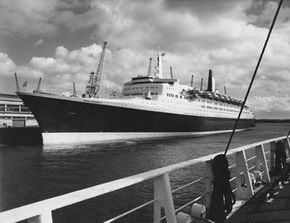
In 1933, two struggling British shipping companies treaded water as the Great Depression sunk hundreds of businesses. Cunard and White Star Lines merged in 1934 and currently operate under the Cunard name, sailing cruise ships you've probably heard of, like the Titanic and the Queen Elizabeth 2, or the QE2, and popularizing the idea of luxury travel by sea.
Unlike the more common cruise ships that ferry people from port to port in the Caribbean, the Mediterranean and some many other corners of the world (including Antartica), these old-school ocean liners still offer that original voyage that so many people signed up for: trans-Atlantic sea passage. Launched in 1967, the QE2, the largest and most extravagant ocean liner of its time built at a cost of $29 million, has made more than 800 trans-Atlantic voyages and logged more than 5.5 million nautical miles [source: BBC , Cunard ].
For nearly half a century, the QE2 ruled the open waters as a reminder of an era gone past -- when people sailed instead of flew, when they packed steamer trunks instead of wheeled suitcases. But times have changed, and even great ships have a lifespan. The QE2, which docks in New York Harbor, sets sail one last time in fall 2008. The Dubai government has purchased the historic vessel for $100 million and plans to turn it into a fancy hotel. While the QE2 is sailing into the sunset, she has plenty of friends that plan to stick around and take advantage of the lucrative cruise industry.
As you are soon to learn, cruise ships like the QE2 are floating resorts full of activities and fine dining. This article will explore the history, mechanics and inner workings of cruise ships, as well as how these giants manage to stay afloat. You'll also hear some cruise ship criticism. So grab your boarding pass and let's set sail through the world of cruise ships.
History of Cruise Ships
How cruise ships float, how cruise ships move, inside a cruise ship: amenities and jobs, cruise ship criticism.
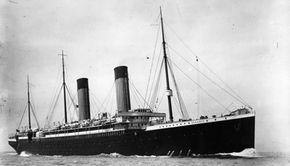
Everyone likes to go on steam engine, a revolutionary way to harness kinetic energy and convert it to power.
As the steam engine evolved, so did its uses, until in 1819 the first American ship aided by a steam engine crossed the Atlantic. The S.S. Savannah left from the U.S. city bearing its name on May 22, 1819, and arrived in Liverpool, England, 29 days later. While the Savannah only used its steam engine for approximately 85 hours (roughly 12 percent of the trip), the voyage made history, and the era of the steamship began [source: Columbia Encyclopedia ].
The passenger ship industry flourished in the late 1800s and early 1900s, courtesy of the steam engine and of the growing number of American immigrants crowding ocean liners. Trans-Atlantic passage was still primarily one way, although affluent passengers traveled back and forth between England and New York for business or holiday.
Ambitious British shipping company White Star Lines began aggressively building the first fleet of ocean liners in 1849 and would revolutionize trans-Atlantic passage over the next 60 years. White Star set records in size and grandeur, building, among others, three large ships dubbed Olympic Class liners. The Olympic, Britannic and Titanic broke the mold of traditional ocean liners, and their speed and interior features made other ships look obsolete. But ocean travel was on the verge of changing.
The popularity of trans-Atlantic sea passage gradually declined with the arrival of the airplane. People could fly to more destinations in a fraction of the time it took on an ocean liner, so shipping companies changed their business model to focus on tourism instead of passenger transportation. In 1900, the American-Hamburg Company built the first ship specifically designed for cruises. The Prinzessin Victoria Luise measured 406 feet (124 meters) long by 52 feet (16 meters) wide, and was 4,409 gross tons [source: Norway-Heritage ]. (In nautical terms a ton , typically called a gross register ton or gross ton , does not measure weight; it represents 100 cubic feet of internal capacity.)
During the early 1930s, Nazi leader Adolf Hitler boosted the fledgling cruise industry by offering holiday packages to German workers as part of a state-sponsored effort to unite the nation. Hitler eventually commissioned several new ships for service, making the Nazi Party early pioneers of the cruise ship industry.
Since the early days, cruise ships have shared one universal goal: Don't sink! Learn how they try to avoid that fate on the next page.
The Britannic was the lesser known, but largest and most extravagant, of the three Olympic Class ocean liners built by White Star for trans-Atlantic voyages. However, just months after its completion, the British government enlisted the liner for use as a hospital ship during World War I. The British government retrofitted the liner for its new role in the war effort -- ferrying wounded from Italy to England -- and sent it on its maiden voyage on Dec. 23, 1915, without any of the fanfare the Titanic enjoyed. Less than a year later, HMHS Britannic struck a mine and began sinking at the bow. In just 55 minutes, faster than the sinking of the Titanic, the Britannic sank in the Mediterranean. Of the more than 1,000 people onboard, 30 people died. It remains the largest sunken ocean liner, having never carried a paying passenger. [source: PBS ]
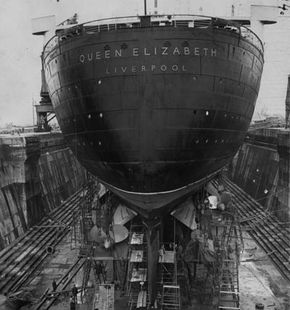
In order for ships to journey across the open sea, they must withstand the tremendous burden , or weight of the ship, along with the crew, luggage, supplies and passengers. They do that with a little help from the principles of density and buoyancy. Cruise ships can weigh upwards of 71,500 tons (65,000 tonnes). They displace the equivalent amount of water when they press down on the ocean, which meanwhile pushes up and keeps the ship afloat, or buoyant .
That's why when engineers talk about how heavy a ship is, you'll hear them talk about displacement instead of weight. To keep from sinking, the cruise ship has to displace its weight in water before it's submerged. That's a lot easier to do if the cruise ship is constructed in a way so that it's less dense than the water below it. Think of it as the difference between dropping a bowling ball in the water and trying to submerge a beach ball. The bowling ball can't displace enough water before it's submerged, so it sinks. The beach ball does the opposite and floats.
Engineers help ships to achieve buoyancy by choosing lightweight, sturdy materials and dispersing the weight of the ship across the hull. The hull , or body of the ship below the main deck, is typically very wide and has a deep base line , or bottom. Large ships such as freighters, naval vessels and transport and cruise ships commonly utilize displacement hulls , or hulls that push water out of the way, to stay afloat.
A round-bottom displacement hull looks like a large rectangle with rounded edges to dissipate drag , or the force exerted against a moving object. The rounded edges minimize the force of the water against the hull, allowing large, heavy ships to move smoothly along. If you somehow hoisted a cruise ship out of the water and looked at it standing a few hundred feet away, the hull would look like a huge capital letter "U," depending on the size of the keel . The keel runs from the bow to the stern and acts as the backbone of the ship.
Like just about everything in our lives, round-bottom displacement hulls have advantages and disadvantages. Unlike a boat with a v-hull, which rises out of the water and skirts the waves, round-bottom hulls move through the water, making them extremely stable and seaworthy. Passengers on these ships rarely feel any rocking or side-to-side movement.
Ships with round-bottom hulls move fluidly, but the resistance of the water makes them extremely slow. They can only go so fast before the addition of more engine power reaches a point of diminishing returns. Nevertheless, the need for stability and a smooth ride outweigh overall speed, thus making the round-bottom displacement hull a good fit for cruise ships.
The hull serves not only as stability but also as protection. Reefs, sandbars and icebergs can tear apart fiberglass, composite materials and even steel. To prevent catastrophic damage, shipbuilders typically construct cruise ships using extra-strength steel and insert double hulls as an extra precaution. A double-hull design is a hull within a hull, like a tire with an inner tube.
Unfortunately, accidents do happen. In order to prevent cruise ships from sinking should something penetrate the first two lines of defense, vertical watertight dividers known as bulkheads are installed throughout the interior of the hull. These dividers keep damaged ships afloat by containing incoming water into a compartment or compartments, thereby preventing the whole ship from flooding.
Now that we've learned how these massive ships float, let's look at the various propulsion systems that propel them from port to port.
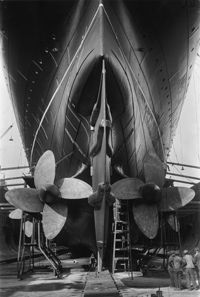
Without a source of power, these mammoth diesel engines to generate power for propulsion. The power of the engine is fed through a transmission to propeller shafts. Transmissions determine the revolutions of the propellers, much like the transmission transfers the engine RPM into manageable speeds to power the rear wheels in our cars. Modern cruise ships use either gas turbine or diesel electric engines as their power source for propulsion, as well as for the ship's systems. The larger the cruise ship, the greater the demand for electrical power. Some larger ships rely on two different power sources: one for propulsion and one exclusively for electrical power.
Aero derivative gas turbine engines generate heat that is converted from mechanical energy into electrical power. To achieve this, compressed air is ignited in a combustion chamber. The hot exhaust is forced over a turbine that spins to mechanically drive a shaft. This power can then be used to spin electrical generators. Diesel-electric engines work much the same way, yet use a direct drive system rather than a turbine. Output shafts are connected to electrical generators to produce electrical power.
Both engine types require fuel, and lots of it. For example, the QE2 consumes about 380 tons of fuel daily if it's traveling at a speed of 28.5 knots and carries enough fuel to sail nonstop for 12 days [source: Warwick ]. Cruise ships usually fill up at various ports, using fueling barges like floating gas stations. They use a lower-grade diesel that tends not to burn as cleanly as road-going diesel-powered vehicles. No doubt when prices rise at the pump, cruise ships also feel the pinch.
All cruise ships rely on propellers to push them through water. Propellers , commonly referred to as screws, cut through the water and provide forward or reverse motion. Unlike airplanes, which require tremendous propeller speeds to provide the forward motion needed for flight, cruise ship propellers do not need to turn as fast. They rely on torque , or brute power, over RPM, or high speed. Therefore, cruise ships travel slowly, rarely topping 30 knots.
Newer, cutting-edge cruise ships, like the QM2, use azimuth thrusters , which are pods housing propellers that can rotate 360 degrees and provide optimum maneuverability. These thrusters replace rudders and are thought to have several benefits over conventional screw-type propeller systems, such as decreased stopping distance and greater fuel efficiency [source: AP ]. They can be used with either gas turbine or diesel electric engines.
If the Titanic had been equipped with azimuth thrusters, things might have turned out differently. One of the Titanic's downfalls was its inability to turn quickly to avoid the iceberg that ripped the bow open. Traditionally, cruise ships rely on rudders and differentiating propeller speed to turn, but ships equipped with azimuth thrusters turn much more quickly, so more cruise ships are incorporating this technology.
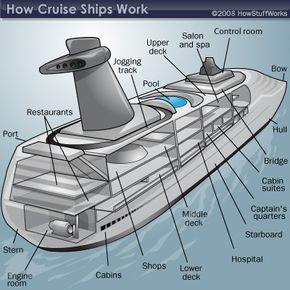
Cruise ships are designed with serious comfort in mind, so they have a lot of amenities and a lot of staff to oversee those amenities for the as many as 3,000 passengers. These thousands of passengers are spread out over the ship's multiple levels called decks . For instance, the QM2 has 13 separate decks and carries up to 3,056 passengers and a crew of 1,253. If you're on deck 13, you would be standing on the highest level of the ship, whereas if you ventured down to the first deck, you'd be closer to the bowels of the ship.
If you booked passage on the QM2, you would likely find yourself staying in one of the Britannia staterooms (or cabins) located in the middle decks. The smallest of these rooms (typically 155 square feet to 250 square feet) contain a king-size bed, closet, television, a phone and a desk. Go with money to blow, and you could find yourself rubbing elbows with the other high rollers on a separate deck where the deluxe apartments and suites are. One of these rooms can be as big as 2,250 square feet. That's as large as a four-bedroom house. Whatever you need -- whether it's an Xbox or a bottle of bubbly -- these are the accommodations where you'll get it fast.
After a good night's sleep, you would probably head to the upper decks to eat breakfast, choosing from one of the many restaurants. Rather than returning to your stateroom after breakfast, you might hang poolside, shoot some hoops, shop, check out the golf simulator or gamble. Of course, you could always venture off the ship if you're at a port of call.
After a packed day, nightfall brings with it more food. You may want to try a formal restaurant or grab something quick at one of the grills. With dinner done, the nightlife begins. If you're in the mood for the opera, you'll need to book a reservation at the Royal Court Theatre. Perhaps you just want to hang out, have a few drinks and dance at the Q32 Nightclub.
Wherever you are on the cruise ship and whatever you're doing, it's likely that a crew member isn't too far away since cruise ships employ very large crews, well over 1,000 people. Here's a list of some of the more nautically inclined crew members and some of their responsibilities.
- Captain - Highest-ranking official on board. Responsibilities include navigation, crew management and executive decision-making. This is the person you'll want to dress up for if you're invited to dine at the captain's table.
- Chief Officer - Responsible for training seamen and maintaining the ship
- Chief Medical Officer - A medical doctor who can perform surgery and supervise all medical operations
- Staff Captain - Also known as the executive officer and the captain's right-hand man
- Chief Engineer - Oversees the mechanical aspects of the ship and its engines
- Chief Radio Officer - Handles all communication, radar and weather systems
In addition, some of the staff focuses less on how the boat is running and more on how you're enjoying yourself. Since cruise ships truly are hotels on the sea, some of the folks you may encounter include bartenders, plumbers, electricians and ushers. Working on a cruise ship can be rewarding and financially appealing. Employees can earn up to five times what they might make on land, depending on which ship and company they work for.
But not everything is fun and games when you're sailing along with thousands of strangers over the open seas. The next section points out some of the drawbacks of cruise ships.
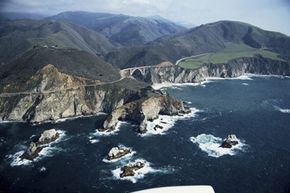
A floating resort packed with thousands of tourists and staff is bound to run into some trouble. The cruise industry has drawn the ire of many public health and environmental critics, not to mention law enforcement and legislators. Let's start with the environmental criticism first.
As you may expect, cruise ships generate several forms of pollution as they lumber through the seas.
- Black water : Wastewater comprising human waste.
- Gray water : Wastewater that comes from showers, dishwashers, sinks and other cleaning activities onboard a ship.
- Bilge water : Water from the ship's bilge tank that contains engine oil and sludge.
- Solid waste : Trash consisting of plastic and metal containers, usually ends up as incinerated ashes.
- Hazardous waste : Cleaning chemicals, paints, solvents and dry cleaning chemicals that find their way into the gray water source or the bilge tank.
[source: Herz , IICRC]
An average cruise ship creates an estimated 90,000 gallons to 255,000 gallons (340,687 liters to 965,280 liters) of gray water, 30,000 gallons (113,562 liters) of black water and 37,000 gallons (140,060 liters) of bilge water daily [source: Herz ]. Loose environmental requirements allow cruise ships to dump everything overboard except untreated and solid waste. Bilge water, gray water, as well as treated sewage and incinerated solid waste can be, and regularly is, dumped directly into the sea, so long as it is not within 3 miles (4.8 km) of the shore.
Ballast water taken on to stabilize the ship can also disrupt ecosystems. Ships inevitably fill their ballast tanks in one location and purge them in a different area, thus introducing new species of marine organisms into different environments. Much like kudzu when it was introduced to the U.S., foreign microorganisms can infect or kill native plankton, sea plants, coral, and fish.
From a public health perspective, disease outbreaks on ships are also a concern. Most of the major cruise lines -- Carnival Cruise Lines, Norwegian Cruise Lines, Celebrity Cruises and Princess Cruises among others -- have reported outbreaks, according to the U.S. Centers for Disease Control. The organism responsible for getting passengers sick usually is the norovirus , a common virus linked to gastroenteritis (the "stomach flu"). Norovirus infections spread quickly on a cruise ship due to the close quarters. To see the cruise ship inspections for a particular ship, visit the CDC Vessel Sanitation program Web site , which posts inspection reports.
Probably one of the most frustrating aspects of traveling on a cruise ship is the lawlessness. Several critics point out that cruise companies are more concerned with protecting themselves from liability. Cruise companies are hesitant to have legitimate security forces onboard ships for fear of lawsuits from the public.
Overcrowding also has become a deterrent for people taking cruises, especially as companies like Royal Caribbean, Cunard and Carnival push the limits of occupancy. Lines to participate in the onboard attractions keep growing as ships like the Genesis hit the water. Slated to arrive sometime in 2009, the Genesis, with a price tag of $1.4 billion, will be 1,180 feet (360 meters) long and will accommodate 5,400 passengers at double occupancy [source: AP]. These mobs of passengers can also overwhelm a port call destination. But cruise ship companies show no signs of stopping their quest to build the biggest ship.
Lots More Information
Related articles.
- How Cruises Work
- How to Survive a Sinking Ship
- How Houseboats Work
- How Steam Engines Work
- How Sailboats Work
- How Sailing Works
- Taken by the Sea: 11 Real-life Shipwrecks
More Great Links
- Cunard Ships
- CDC Vessel Sanitation Program
- AP. "Royal Caribbean Ships Orders $1.24B Cruise Ship." CBS News. Feb. 6, 2006. (April 29 2008) http://www.cbsnews.com/stories/2006/02/06/ap/business/mainD8FJQAOO1.shtml
- BBC. "QE2 departs on final world trip." Jan. 6, 2008. (April 22, 2008)http://news.bbc.co.uk/2/hi/uk_news/england/hampshire/7173887.stm
- Bowman, Frank. "An Integrated Electric Power System: The Next Step." (April 8, 2008)http://www.navy.mil/navydata/cno/n87/usw/issue_9/power_system.html
- Cunard. "Queen Elizabeth 2 Ship Facts." (April 23, 2008)http://www.cunard.com/OurShips/default.asp?Ship=QE2&main=int
Please copy/paste the following text to properly cite this HowStuffWorks.com article:
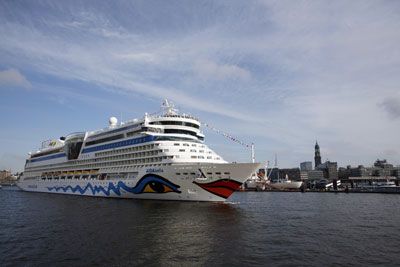
- Outdoor Activities
- Destinations
- Book Hotels, Flights & Cars
- Advertise With Us
- Cookie Settings
Copyright © 2024 MapQuest Holdings LLC, a System1 Company
A company is turning former cruise ships into floating hotels — see inside its largest 'floatel'
- Bridgemans ServicesGroup operates a fleet of former cruise ships turned into hotels.
- Its "floatels" are designed to house workers during long-term projects.
- See its largest 652-cabin floatel with a game room and buffet.

Some old and unwanted cruise ships meet their demise at ship-breaking yards , where they are disassembled and sold for scrap.
Other vessels find a more fortunate fate, receiving a second chance to do what they already do best: serve as floating hotels.
Canada-based Bridgemans Services Group buys and charters former cruise ships to turn into "floatels," outfitted with standard cruise amenities like daily housekeeping, buffets, and relaxing lounges.
But the ships aren't designed to transport tourists from one destination to another anymore. Instead, companies turn to Bridgeman when they need to house workers for a long-term project, whether it be the construction of an offshore wind farm in Europe or the shooting of a major film in a remote destination.
Floatels can accommodate workers in remote destinations where hotels might not be an option.
In more metropolitan areas, Bridgemans says its ships could lessen the stress an inundation of workers might have on the local housing market.
And once they are no longer needed, the vessels depart and "leave no trace behind," the company said.
Over the last decade, Bridgemans has deployed its ships for 15 projects on every continent, Brian Grange, the company's president, told Business Insider.
Grange said that its deployments — most often for liquified natural gas companies — last for an average of two years.
In the past, it has also provided accommodations for MSC Cruises at its Ocean Cay private island and housing for more than 1,000 workers in the Philippines' on a project for the Manila International Airport during the COVID-19 pandemic.
The company's three ships range from 150 to 652 cabins.
The floatel operator acquired its largest ship, the 561-foot-long MV Isabelle X, in 2023.
In its past life, the 35-year-old vessel sailed around the Baltic Sea as one of Estonia-based Tallink Gruipp's cruise ships.
But gone are its days of leisurely cruising. The 35,000 gross-ton ship is now on its first deployment in Howe Sound, just north of Vancouver, where it's housing more than 600 workers who are building Woodfibre LNG's "net zero" LNG export facility.
Isabelle X underwent a six-month retrofit before it was sent to Howe Sound.
The process included updating the ship's cabins and adding amenities like a game room and an 8,000-square-foot gym.
The latter two are especially important: "We need to make sure we delineate between work and home," Grange told BI. "We have to create a social environment on board these vessels that makes it attractive for workforces around the world."
During their free time, workers can play billiards, relax in the outdoor lounge, or use the ship’s WiFi to catch up on social media.
The sports lounge has large television screens, while the games lounge has darts, ping pong tables, and air hockey.
The 'quiet lounges' are the go-to space for people who need to unwind after a long work day.
Or, they could recharge and catch up on the latest shows in their cabins, which all come with desks, storage, and 32-inch televisions.
Like a typical cruise ship, Bridgemans' vessels have buffets with live cooking stations, a dessert bar, and the occasional themed night.
The ships' chefs tailor their menus to the demographic and dietary restrictions of the workers on board, the company's president told BI.
Residents can expect at least four protein options, plenty of veggies, and handmade bread and desserts.
Unlike most cruise lines, Bridgemans can pre-purchase all the food it needs before deployment.
Grange says this allows the ships to maintain food quality and consistency in remote locations.
Remember that deployment in the Philippines during COVID-19? He said the ship had packed almost 800 tons of food ahead of the project.
He wouldn’t disclose the cost to rent one of Bridgemans’ floatels.
But he did note that the cost of a cabin on the Woodfibre LNG project in Howe Sound is comparable to a hotel room in nearby Vancouver, as is the case with most of its projects near major cities.
The company’s most recent acquisition, the 150-cabin Diamond XI, is currently being retrofitted and would be ready for deployment this year.
According to the company's president, the vessel is small and high-end, likely to be used for sporting events and movie shoots.
It could also be the start of a greater expansion: He hopes to add two or three more vessels to its fleet in the next five years.
"The world has opened up to this as a valued alternative to housing," Grange told BI.
Who knows, the next time you see a cruise ship off the coast, there's a slim but possible chance it could be housing workers — not vacationers.
- Main content

- News Archive
- Get Daily Email

- News & Features
- Bunker Prices
- Bunker Intelligence
- Asia/Pacific
- News & Features
Sallaum Lines Takes on Bunker-Saving Wärtsilä Systems for Six New PCTCs

The vessels are under construction in China. Image Credit: Sallaum Lines
Shipping firm Sallaum Lines is taking on a range of bunker-saving systems from engineering company Wärtsilä for six new pure car and truck carriers .
Wärtsilä will supply 20DF dual-fuel auxiliary gen-sets, operating mainly on LNG, as well as transverse thrusters and main engine control systems for each of the six new ships, it said in an emailed statement on Tuesday.
For four of the vessels, it will also supply shaft generator systems to reduce the auxiliary gen-sets' running hours at sea.
The vessels are under construction in China, and will start to receive the new equipment this year.
"Sallaum Lines is committed to sustainability and to reducing our environmental impact through implementing eco-friendly practices and reducing emissions," Puneet Arora , technical manager at Sallaum Lines, said in the statement.
"We are moving forward to a sustainable future by working to achieve zero emissions by 2050. This is why we have selected Wärtsilä to partner with us for these six new ships."
Ship & Bunker News Team To contact the editor responsible for this story email us at [email protected]
Also in the News

Panama Records Lowest Q1 Bunker Sales Since 2016
Relatively robust March sales of 390,678 mt couldn't mask the effects of low water levels limiting transits through the Canal.
Read in Full

Singapore-Rotterdam Green Corridor Plans Bio-LNG Bunkering Pilots in 2024-5
Partners to the initiative plan to carry out the operations in 2024 and 2025.

Singapore Firms Sign Biofuel Partnership
The two companies signed a memorandum of understanding at a Singapore Maritime Week event on Tuesday.
Key Bunker Prices More
Popular now more.

- Terms of Use
- Privacy Policy
- Latest News
- Americas News
- Asia/Pacific News
- Regional Bunker Prices
- Americas Bunker Prices
- EMEA Bunker Prices
- Asia/Pacific Bunker Prices
- Latest Bunker Prices
- LA / Long Beach Bunker Prices
- Houston Bunker Prices
- New York Bunker Prices
- Rio de Janeiro Bunker Prices
- Rotterdam Bunker Prices
- Fujariah Bunker Prices
- Singapore Bunker Prices
- Hong Kong Bunker Prices
- RSS & Twitter

IMAGES
VIDEO
COMMENTS
Cruise ships require a lot of power. And rightfully so! As they carry close to 3000 passengers with 500-1000 crew members at any time. Most of the power of the ship is consumed by the large air-conditioning plant that takes care of passenger comfort in suites and public spaces. The propulsion plant of cruise ships, consisting of giant ...
The same way works diesel-electric engines, yet they use a direct drive system, not a turbine. The output shafts, to produce electrical power, are connected to generators. ... The main advantage of the diesel-electric cruise ship engine systems is efficiency as they allow main engines to operate near the most efficient speed, no matter if the ...
Conventional Diesel. Despite the colloquialism of "steaming to St. Thomas," the days of steam engines in ships have all but disappeared. (The last passenger ship built with a steam engine ...
When it comes to cruise ships, the typical engine is a two 16-cylinder Wartsila 16V 46D which is a common rail engine. They also use three 12-cylinder Wartsila 12V 46D engines to power the ship ...
The Engine Room. The engine room is the heart of a cruise ship. It is here that pistons hammer and crankshafts turn to propel the ship forward. It is the loud and oily place where the Chief Engineer and his team work around the clock to ensure that everything is running smoothly.
A cruise ship engine room spans several decks and holds the ship's engines, fuel tanks, water systems, generators, control room, engine workshop, air conditioning, and other essential navigation systems. ... If the generators fail to work during an emergency, cruise ships have an emergency battery backup to power the most critical systems for ...
One of the world's largest cruise ship, "Symphony of the Seas". Inside overview: how they work, how the world's largest ship engines are assembled for an oce...
They work the same way that diesel-electric propulsion systems do, and the heat that the turbines generate is often used for onboard electricity. Gas turbines are a relatively new cruise ship power system, but they will probably be used more frequently. ... The cruise ship engine room is usually located on the lowest deck. Ships designers have ...
Cruise ships are some of the largest ships on the water by volume and by the number of people carried, they have every other ship beat. The world's largest cruise ship, Harmony of the Seas, can ...
How does a cruise ship work? First and foremost, a cruise ship's heart is in the engine of the vessel. The engine's design, paired with proper fueling, provides the power for the ship's mobility and all the entertainment aboard. The ship's engineering and the logistics of running a cruise company play a role in shaping how a cruise ship ...
Cruise ships come in all shapes and sizes, and their engines vary as well. Cruise ships use a variety of power sources to propel them from port to port, including diesel engines, gas turbines, steam turbines, and even nuclear power. The type of engine chosen depends on the size of the ship and its intended purpose.
Engineers: Cruise ship engines are located near the bottom of the ship as they are heavy, and they are usually towards the aft of the ship. Cruise ships use Diesel-Electric propulsion systems. The main engines are generators which produce electricity which then powers the azipods. VV ships have 4 engines and 2 azipods.
How are the world's largest ship engines assembled?Monster Machines is a program about the creation and organization of the giants of modern engineering. Ful...
Diesel engines are the most commonly used type of engines in cruise ships. These engines work by compressing air in the cylinders and injecting fuel, usually diesel, into the compressed air, leading to combustion. The combustion process generates the power needed to propel the ship and generate electricity for onboard systems. Diesel engines ...
This survey is integrated with our cruise ship engines-propulsion-fuel and cruise safety articles. The actual cruise shipbuilding takes 2 to 3 years (the design plans are usually started a year ahead). Shipbuilding takes place in specialized facilities called shipyards. ... The cruise ship design company (whose work is also called naval ...
LNG-powered cruise ships utilize dual-fuel engines that can operate on both LNG and marine diesel oil, providing flexibility and improving fuel efficiency. ... The crew and staff on a cruise ship work tirelessly behind the scenes to ensure that every aspect of the operation runs smoothly. Their professionalism, expertise, and commitment to ...
History Pre-mechanization Marine steam reciprocating engines, ca. 1905 A wind propelled fishing boat in Mozambique. Until the application of the coal-fired steam engine to ships in the early 19th century, oars or the wind were the principal means of watercraft propulsion. Merchant ships predominantly used sail, but during periods when naval warfare depended on ships closing to ram or to fight ...
Modern cruise ships use either gas turbine or diesel electric engines as their power source for propulsion, as well as for the ship's systems. The larger the cruise ship, the greater the demand for electrical power. Some larger ships rely on two different power sources: one for propulsion and one exclusively for electrical power.
In this video, we're going to take a look at how ship engines are tested. We'll see how the engines are inspected and tested, and we'll learn about the diffe...
The most noteworthy is the engine requirements the cruise ships need to run on this fuel. LNG is unable to go into existing diesel or gas engines. Therefore, ships must be designed using a ...
Apr 24, 2024, 2:04 AM PDT. Walter Biscardi on the Oceania Sirena in December 2023. Walter Biscardi. Walter Biscardi runs his travel business remotely from cruise ships for three months each year ...
In fact, it's common not to have all engines going at once in order to conserve wear and tear. When a situation like this occurs, the ship can still operate at a reduced speed safely. Historically, ships with propulsion problems have been able to sail and either make repairs along the way, or hold off until a scheduled upcoming dry dock.
Isabelle X is docked at the construction site, allowing workers to walk to work. Bridgemans Services Group The floatel operator acquired its largest ship, the 561-foot-long MV Isabelle X, in 2023.
Virgin Voyages is one of the few that includes it in your cruise fare, but if you sail on Carnival, Royal Caribbean, or most other popular cruise lines, expect to pay anywhere from $15-$30 per day ...
Shipping firm Sallaum Lines is taking on a range of bunker-saving systems from engineering company Wärtsilä for six new pure car and truck carriers.. Wärtsilä will supply 20DF dual-fuel auxiliary gen-sets, operating mainly on LNG, as well as transverse thrusters and main engine control systems for each of the six new ships, it said in an emailed statement on Tuesday.